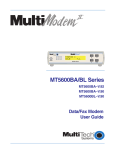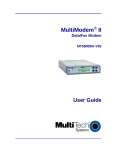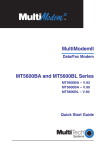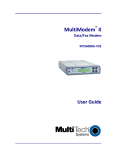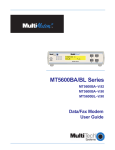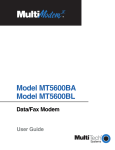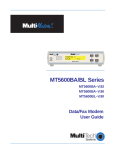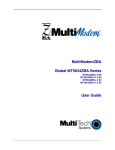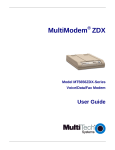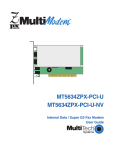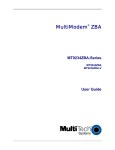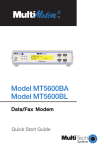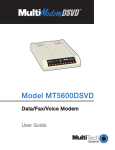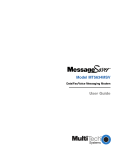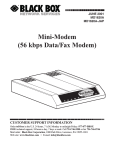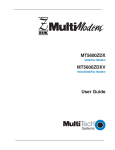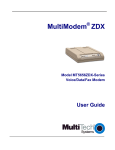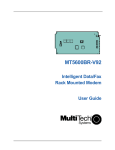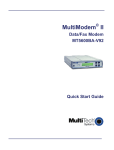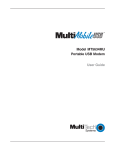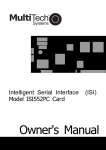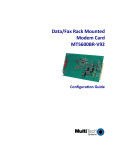Download Multi-Tech Systems MT5600BAV.90 User's Manual
Transcript
MT5600BA/BL Series MT5600BA–V.92 MT5600BA–V.90 MT5600BL–V.90 Data/Fax Modem User Guide MultiModemII User Guide MT5600BA–V.92, MT5600BA–V.90, MT5600BL–V.90 P/N S000276C Revision C ©2003 by Multi-Tech Systems, Inc. All rights reserved. This publication may not be reproduced, in whole or in part, without prior expressed written permission from Multi-Tech Systems, Inc. Multi-Tech Systems, Inc. makes no representations or warranties with respect to the contents hereof and specifically disclaims any implied warranties of merchantability or fitness for any particular purpose. Furthermore, Multi-Tech Systems, Inc. reserves the right to revise this publication and to make changes in the content hereof without obligation of Multi-Tech Systems, Inc. to notify any person or organization of such revisions or changes. Record of Revisions Revision Date Description A 10/03/02 Initial release of MT5600BA Global V.92. (Also replaces S0000129 Rev. C - the MT5600BA/BL User Guide). B 02/17/03 Changed cover. Changed text to indicate that the following are implemented: V.25bis HDLC NRZ?, V.25bis HDLC NRZI?, and V.25bis BISYNC C 07/31/03 Added setting the country code using the LCD panel. Add country codes list. Trademarks MultiModemII, Multi-Tech, and the Multi-Tech logo are trademarks of Multi-Tech Systems, Inc. Adobe and Acrobat are trademarks of Adobe Systems Incorporated. Microsoft, Windows, Windows 98/ Me/NT/2000/XP are either registered trademarks or trademarks of Microsoft Corporation in the United States and/or other countries. All other brand and product names mentioned in this publication are trademarks or registered trademarks of their respective companies. Patents This device is covered by one or more of the following patents: 6,031,867; 6,012,113; 6,009,082; 5,905,794; 5,864,560; 5,815,567; 5,815,503; 5,812,534; 5,809,068; 5,790,532; 5,764,628; 5,764,627; 5,754,589; 5,724,356; 5,673,268; 5,673,257; 5,644,594; 5,628,030; 5,619,508; 5,617,423; 5,600,649; 5,592,586; 5,577,041; 5,574,725; 5,559,793; 5,546,448; 5,546,395; 5,535,204; 5,500,859; 5,471,470; 5,463,616; 5,453,986; 5,452,289; 5,450,425; D353,598; 5,355,365; 5,309,562; 5,301,274. Other patents pending. World Headquarters Multi-Tech Systems, Inc. 2205 Woodale Drive Mounds View, MN 55112 U.S.A Telephone (763) 785-3500 or (800) 328-9717 Fax (763) 785-9874 Technical Support (800) 972-2439 Internet http://www.multitech.com Contents Table of Contents Chapter 1 - Description and Features ......................................................................... 5 Product Description .............................................................................................. 5 Features ............................................................................................................... 5 Safety Warnings .................................................................................................. 6 Chapter 2 - Installation ............................................................................................... 7 Step 1 - Connect the Modem to Your System ...................................................... 7 Step 2 - Install the Modem Driver ......................................................................... 9 Removing an Old Modem Driver .......................................................................... 9 Step 3 - Setting Your Country Code ................................................................... 10 Step 4 - Install PhoneTools ................................................................................ 11 Chapter 3 - Using the Front Panel ............................................................................ 12 Modem Configuration ......................................................................................... 12 LED Indicators ................................................................................................... 12 Liquid Crystal Display (LCD) .............................................................................. 13 Option Selection .......................................................................................... 13 Menu Structure ............................................................................................ 13 Menu Overview .................................................................................................. 14 Status Trunk ................................................................................................ 15 Basic Options Trunk .................................................................................... 16 Advanced Options Trunk ............................................................................. 18 Remote Configuration Options Trunk ........................................................... 20 Diagnostic Options Trunk ............................................................................ 20 Phone Number Memory Options Trunk ....................................................... 21 Caller ID Options Trunk ............................................................................... 21 Menu Options .............................................................................................. 22 Status .......................................................................................................... 22 Basic Options .............................................................................................. 23 Advanced Options ....................................................................................... 25 Remote Configuration Options ..................................................................... 27 Diagnostic Options ...................................................................................... 27 Phone Number Memory Options ................................................................. 27 Caller ID Options ......................................................................................... 28 Chapter 4 - Leased Line Operation .......................................................................... 29 Two-Wire Setup ................................................................................................. 29 Four-Wire Setup ................................................................................................ 30 Dial Backup and Leased-Line Restoral .............................................................. 31 Dial Backup and Leased Line Restoral Setup .................................................... 31 Chapter 5 - Remote Configuration ............................................................................ 33 Basic Procedure ................................................................................................ 33 Setup ................................................................................................................. 33 Changing the Remote Configuration Password.................................................. 33 Changing the Remote Escape Character ........................................................... 34 Chapter 6 - Callback Security ................................................................................... 35 Setup Procedures .............................................................................................. 35 Turning Callback Security On and Off ................................................................ 35 Assigning Callback Passwords .......................................................................... 36 Calling Procedure .............................................................................................. 38 Callback Security Commands ............................................................................ 39 Callback Assignments Form .............................................................................. 40 Multi-Tech Systems, Inc. MT5600BA/BL Series User Guide 3 Contents Chapter 7 - Troubleshooting ..................................................................................... None of the Indicators Light ............................................................................... The Modem Does Not Respond to Commands .................................................. The Modem Cannot Connect When Dialing ....................................................... The Modem Disconnects While Online .............................................................. The Modem Cannot Connect When Answering ................................................. File Transfer Is Slower Than It Should Be .......................................................... Data Is Being Lost .............................................................................................. There Are Garbage Characters on the Monitor .................................................. The Modem Doesn’t Work with Caller ID ........................................................... Fax and Data Software Can’t Run at the Same Time ......................................... Appendix A - Regulatory Compliance ....................................................................... FCC Part 68 Telecom ........................................................................................ Fax Branding Statement .................................................................................... Canadian Limitations Notice ............................................................................... EMC, Safety, and R&TTE Directive Compliance ................................................ International Modem Restrictions ....................................................................... New Zealand Telecom Warning Notice .............................................................. South African Notice .......................................................................................... Appendix B - Technical Specifications ...................................................................... Appendix C - Warranty, Service, and Technical Support .......................................... Multi-Tech Systems, Inc. Warranty & Repairs Policies ...................................... Online Warranty Registration ............................................................................. Service ............................................................................................................... Replacement Parts ............................................................................................ Technical Support .............................................................................................. Internet Sites ...................................................................................................... Appendix D - Upgrading the Firmware ..................................................................... Introduction ........................................................................................................ Upgrade Overview ............................................................................................. Step 1 - Identify the Modem Firmware ............................................................... Step 2 - Identify the Current Firmware Version .................................................. Step 3 - Download the Upgrade File .................................................................. Step 4 - Extract the Upgrade Files ..................................................................... Step 5 - Clear Your Stored Paramenters ........................................................... Step 6 - Upgrade the Modem’s Firmware........................................................... Step 7 - Restore Your Parameters ..................................................................... Appendix E - Installing a Modem Under Linux .......................................................... Introduction ........................................................................................................ Standard Linux Serial Port Definitions ................................................................ Installation .......................................................................................................... Setup ................................................................................................................. Appendix F - Pin Descriptions .................................................................................. RS-232 Pin Descriptions .................................................................................... RS-232 Cable Pinouts ....................................................................................... Leased Line Pinouts .......................................................................................... Index ........................................................................................................................ Multi-Tech Systems, Inc. MT5600BA/BL Series User Guide 41 41 42 43 44 45 45 45 46 46 46 47 47 48 48 49 49 49 50 51 53 53 54 54 55 56 56 57 57 57 57 58 58 58 59 59 59 60 60 60 60 60 62 62 63 64 65 4 Chapter 1 - Description and Features Chapter 1 - Description and Features Congratulations on your purchase of the MultiModemII modem. You have acquired one of the finest intelligent data/fax modems available today from one of the world’s oldest modem manufacturers: MultiTech Systems, Inc. This user guide will help you install, configure, test and use your modem. Product Description This modem supports two-wire and/or four-wire leased lines. The four-wire leased line includes the dial backup and automatic leased line restoration features. Please note that, because leased-line operation consists of two client modems connected to each other, the maximum leased line data rate is 33.6K bps. The MT5600BA-V.92 modem supports both two-wire and four-wire leased lines. The MT5600BA modem supports a two-wire leased line. The MT5600BL modem supports a four-wire leased line. The MultiModemII offers interactive automatic dialing. You can store four command lines or telephone numbers of up to 30 characters each in the modem’s nonvolatile memory. The modem pulse- or tonedials, and recognizes dial tones and busy signals for reliable call-progress detection. It can also detect AT&T calling card tones. It is FCC-registered for connection to telephone networks without notification to the telephone company. The MultiModemII front panel includes a liquid crystal display and four buttons, which together can be used to either display the current connection status of the modem or to configure the modem. The MultiModemII also can be configured through standard AT commands. About AT Commands AT Commands for this product are published in a separate document and included on the MT5600BA/BL System CD that accompanies your modem. Features General • Complies with major international standards to ensure compatibility with other modems. • Uses DTMF and tone detection to distinguish data and fax calls when used with software that supports these features. • Supports serial port speeds to 230.4K bps with compatible serial ports • Supports Caller ID (North American versions only). • Displays status and configuration information on a front panel LCD. Data • Supports automatic fallback to slower speeds in noisy line conditions, and fall-forward to faster speeds as conditions improve. • Supports both synchronous and asynchronous data transfer. • Support two-wire leased line operation. Also supports four-wire leased line operation with dial backup and leased line restoration. • Supports callback security and remote configuration. • Supports AS400 applications. • Automatically disables compression when transferring already-compressed files. • Can autodial, redial, pulse (rotary) and touch-tone dial. • Detects dial tones and busy signals for reliable call-progress detection. • Compatible with the standard AT command set used by most communication programs. • Supports Plug and Play (PnP). • Can be flash upgraded. Fax • Supports V.17, Class 1, and Group 3 fax standards, (V.92 support Class 2 also) allowing it to communicate with other fax modems as well as with fax machines. Multi-Tech Systems, Inc. MT5600BA/BL Series User Guide 5 Chapter 1 - Description and Features Safety Warnings • • • • • • • • Use this product only with UL- and CUL-listed computers. To reduce the risk of fire, use only 26 AWG or larger telephone wiring. Never install telephone wiring during a lightning storm. Never install a telephone jack in a wet location unless the jack is specifically designed for wet locations. Never touch uninsulated telephone wires or terminals unless the telephone line has been disconnected at the network interface. Use caution when installing or modifying telephone lines. Avoid using a telephone during an electrical storm; there is a risk of electrical shock from lightning. Do not use a telephone in the vicinity of a gas leak. Multi-Tech Systems, Inc. MT5600BA/BL Series User Guide 6 Chapter 2 - Installation Chapter 2 - Installation Step 1 - Connect the Modem to Your System Turn off your computer. Placing the modem in a convenient location, connect it to your computer’s serial port, to the telephone line, to your leased line, to AC power, and, optionally, to your telephone. PHONE LINE LEASED EIA RS232C VOLUME POWER or MultiModemII connections with V.92 transformer and V.90 transformer. Connect the Modem to Your PC Plug one end of the serial cable into the RS-232 connector on the modem, and the other end into a serial port connector on your computer, such as COM1 or COM2. Connect the Modem to the Telephone Line (Dialup Connection) Plug one end of the modular phone cable into the modem’s LINE jack, and the other end into a public switched telephone network (PSTN) wall jack. Important: The LINE jack is not interchangeable with the PHONE jack. Do not plug the phone into the LINE jack or the line cable into the PHONE jack. Note: Regulatory agencies may impose certain restrictions on equipment connected to public telephone systems. Connect theTwo-Wire Leased Line MT5600BA – Plug one end of a two-wire phone cable into the modem’s LINE jack; connect the other end to a leased line wall jack or terminals. MT5600BL – Plug one end of a two-wire phone cable into the modem’s LEASED jack; connect the other end to a leased line wall jack or terminals. Multi-Tech Systems, Inc. MT5600BA/BL Series User Guide 7 Chapter 2 - Installation Connect the Four-Wire Leased Line MT5600BL Only – Plug one end of a four-wire phone cable into the modem's LEASED jack; connect the other end to a four-wire leased line wall jack or terminals. Modems with a leased-line jack support the dial backup feature. For dial backup operation, plug one end of your dialup modular phone cable into the modem’s LINE jack and the other end into a PSTN wall jack.Plug one end of a two-wire or four-wire phone cable into the modem’s LEASED jack, and connect the other end to a leased-line wall jack or terminals. Modems with a leased-line jack support the dial backup feature. For dial backup operation, plug one end of your dialup modular phone cable into the modem’s LINE jack and the other end into a PSTN wall jack. Connect the Phone to the Modem (Optional) For voice-only calls, plug a telephone into the modem’s PHONE jack. Connect the Modem to the AC Power Outlet Plug the power transformer into an AC power outlet or power strip. Plug the power transformer’s cable into the POWER jack on the modem. Note: Use only the power transformer supplied with the modem. Use of any other transformer voids the warranty and can damage the modem. Power-On Test Test the modem by turning it on (a power switch is located on the front panel). When you apply power, the modem performs a diagnostic self-test, indicated by the TM indicator lighting for a few seconds, after which the LCD should light. If this does not happen, check that the power switch is on, the power transformer is solidly connected, and the AC outlet is live. If these measures do not work, see the “Troubleshooting” chapter. Multi-Tech Systems, Inc. MT5600BA/BL Series User Guide 8 Chapter 2 - Installation Step 2 - Install the Modem Driver If you use Windows 98/Me/NT 4.0/2000/XP; you must install the modem driver. The drivers are installed easily since Windows supports Plug-and-Play. Installing the Modem Driver for Windows 98/Me/2000/ XP 1. Make sure your modem is connected properly, and then turn on your computer. Windows should detect your new modem and open the Install New Modem wizard. Note: If Windows cannot find a modem, your modem may be turned off, it may be plugged into the wrong connector on your computer, or the serial cable may be faulty. See “None of the LEDs Light When the Modem Is Turned On” and “The Modem Does Not Respond to Commands” in the “Troubleshooting” chapter. 2. Insert the MultiModemII system CD into your CD-ROM drive, and then click OK. 3. Windows installs and configures the modem. 4. Click Finish to exit. Installing the Modem Driver for Windows NT 1. Make sure your modem is connected properly, and then turn on your computer. Windows should detect your new modem and open the Install New Modem wizard. Note: If Windows cannot find a modem, your modem may be turned off, it may be plugged into the wrong connector on your computer, or the serial cable may be faulty. See “None of the LEDs Light When the Modem Is Turned On” and “The Modem Does Not Respond to Commands” in the Troubleshooting chapter of the User Guide. 2. In the Install New Modem wizard, select Don’t detect my modem; I will select it from a list, and then click Next. A dialog box with a list of manufacturers and a list of modem models appears. 3. Insert the MultiModemII system CD into your CD-ROM drive, and then click Have Disk. 4. In the Install from Disk dialog box, select the drive that the CD is in, and then click OK. 5. A list of modems appears. Select your modem and click Next. 6. Select the port that the modem is connected to, and then click Next. 7. Windows installs and configures the modem. 8. Click Finish to exit. Removing an Old Modem Driver When your new modem replaces another modem, the old modem driver remains in Windows, and the old modem driver is still selected in HyperTerminal and other Windows applications. Though you can change the application connection descriptions one at a time, it is easier to force Windows applications to use the new modem by removing the old modem driver from Windows. 1. Click the Start button, point to Settings, and click Control Panel. 2. Double-click the Modems icon to open the Modems Properties dialog box. 3. In the list box, select the old modem. 4. Click Remove, and then click Close. 5. The next time you dial a HyperTerminal connection, it will select your new modem and ask you to confirm the selection. Multi-Tech Systems, Inc. MT5600BA/BL Series User Guide 9 Chapter 2 - Installation Step 3 - Setting Your Country Code (MT5600BAV.92 Only) The MT5600BA-V.92 modem is a global modem - it can be used all over the world. Different countries have different requirements for how modems must function. Therefore, before you can use your modem, you must configure it to match the defaults of the country in which you are using it. You can use one of two configuration methods: · Using the LCD Panel to Set Your Country Code · Using the Global Wizard to Set Your Country Code · Using AT Commands to Set Your Country Code Using the LCD Panel Status 1. Start at the Status LCD and use the down arrow to move down the menu tree to the Country Select LCD. Basic Options 2. Use the right arrow to move from the Country Select LCD, across the Country Setting Options LCD, to the Current Setting LCD. Diagnostics 3. If the current setting shown is not the one for your country, arrow across to the Country Profile LCD. The question mark represents the question Is this the country you want? If B5 is the one you want, press Enter; if its not the one you want, arrow across until you see the code you desire. See the list of Country Codes on the back of this card. Phone Number Memory 4.When you reach the country code you want, press Enter. After pressing Enter, you will see the message Option Set. Advanced Options Remote Config Caller ID Country Select 5. After setting the country profile, you can re-power the modem or use the arrows to move back and up the menu tree to return to the Status LCD. Country Setting Options Current Setting Country Profile B5? Country Profile 99? Country Profile 01? Country Profile 02? Country Profile 03? Country Profile 04? Country Profile 00? Country Profile 09? Country Profile 6C? Country Profile 9F? Country Codes · · · · · · · · · · B5 – All countries use the Country Code B5 except for the following codes. 99 – The following countries use the Country Code 99: Hong Kong Israel, Poland Hungary Korea (Democratic People’s Republic of) Slovenia India Korea (Republic of) Vietnam Indonesia Philippines 01 – Argentina 02 – Taiwan 03 – New Zealand 04 – Singapore 00 – Japan 09 – Australia 6C – Malaysia 9F – South Africa Multi-Tech Systems, Inc. MT5600BA/BL Series User Guide 10 Chapter 2 - Installation Using the Global Wizard The Global Wizard configuration utility is recommended for computers running in Windows. The Wizard can configure your modem for a specific country with just a few mouse clicks. 1. Insert the MultiModemII system CD into the CD-ROM drive. The Autorun dialog box appears. 2. Click Initial Setup and Country Selection. The Global Wizard dialog box appears. Click Next. 3. The Global Wizard searches for your modem and identifies it. Click Next after your modem is identified. 4. Select the country in which the modem will be used. Click Next. 5. Review your choice of country. If it is correct, click Next to configure the modem. 6. When the Global Wizard announces that the parameters have been set, click Finish to exit. Using AT Commands If you are comfortable using AT commands, you use them to configure your modem. You must enter these commands in your communication program's terminal window (a program such as PhoneTools). Execute the following AT commands: Type AT+GCI=nn (nn stands for the country code). Press Enter. OK displays. Type AT&F&W to save your country code. Press Enter. OK displays. Type ATI5 to verify your country code has been configured. The country code is then displayed in hexadecimal format as in this example: Country Hexadecimal Code Euro/NAM B5 Note: See Multi-Tech's Web site for a list of country codes. Go to www.multitech.com. Step 4 - Install PhoneTools Note: PhoneTools may or may not be included on the MT5600BA/BL system CD according to your company's preference. Data communications software gives you access to commands that govern how the modem operates; that is, how the modem handles incoming and outgoing data streams, etc. MultiTech includes a data communications software package (PhoneTools) on the product CD shipped with your modem. In general, the modem will work with most data communications software packages. 1. Insert the MT5600BA/BL system CD into your CD-ROM drive. Allow Autorun to bring up the introductory screen. 2. Click on the PhoneTools icon and choose the appropriate country/language. 3. Follow the PhoneTools installation wizard. No input is needed. You may choose to view the “Readme” file and whether or not to run PhoneTools immediately. Windows NT/2000/XP Note: During installation, an advisory screen may appear saying “FAX capture driver installation” - this may cause a delay in the installation. This is normal. The installation process has not failed or stalled. Simply wait a few moments until this screen disappears. 4. After installation, you can launch PhoneTools either from a desktop icon or from the Start | Programs menu. Typically, it’s not necessary to reboot before using PhoneTools. Multi-Tech Systems, Inc. MT5600BA/BL Series User Guide 11 Chapter 3 - Using the Front Panel Chapter 3 - Using the Front Panel Like any modem, your Multi-Tech modem operates only under the control of a communication program, such as the PhoneTools program included with the modem. It also operates under other general-purpose data communication programs, such as Windows Terminal and HyperTerminal. For information on how to use the modem with the communication program of your choice, please refer to the program’s documentation. Modem Configuration Your modem normally is configured through Windows or through the communication program you are using. The default settings work best for most purposes. See “Step 4: Install PhoneTools” in Chapter 2 for help in setting up your communication program. You also can configure your modem either through the front panel or by sending AT commands to the modem. The AT commands can be found in the AT Reference Guide on the CD shipped with this modem. Figure 3-1. Front panel LED Indicators The MT5600BA-V.92 has six LED indicators on the front panel that indicate status and activity: Receive Data. The RD indicator flashes when the modem is receiving data. Transmit Data. The TD indicator flashes when the modem is transmitting data. Carrier Detect. The CD indicator lights when the modem detects a valid carrier signal from another modem. It is on when the modem is communicating with the other modem, and off when the link is broken. Off-Hook. The OH indicator lights when the modem is off-hook, which occurs when the modem is dialing, online, or answering a call. The LED flashes when the modem pulse-dials. Terminal Ready. The TR indicator lights when a communication program is using the modem. It means the modem is ready for an outgoing or incoming call. It goes off when the communication program disconnects the serial port. When it goes off, a connected modem will disconnect. Test Mode. The TM indicator lights when the modem is in test mode. Multi-Tech Systems, Inc. MT5600BA/BL Series User Guide 12 Chapter 3 - Using the Front Panel Liquid Crystal Display (LCD) The MultiModemII’s backlit liquid crystal display (LCD) has two functions: to display the current status of the modem and to display configuration menus, which are selected using the four pushbuttons on the front panel. Option Selection To select most configuration options, simply display the option in the LCD, and then press the Enter button to select it. An OPTION SET message appears to confirm the selection. To exit the OPTION SET message, press any button. Some options, such as password options and phone number options, require you to enter a character string. To select a character, press the áß and â buttons. To go to the next character position, press the à button. To backspace, press the à button before selecting a character. To exit without saving, press the à button several times. To save a character string, press the Enter button. Menu Structure The LCD menus have a tree structure with multiple trunks, limbs, branches, and twigs. For a schematic view, refer to the menu map on the next page. Trunks are the major divisions of the menu tree. There are seven trunks: Status, Basic Options, Advanced Options, Remote Configuration, Diagnostics, Phone Number Memory, and Caller ID. Use the áß and â buttons to move between trunks. Limbs are subdivisions of trunks. Use the à button to move from a trunk onto its first limb, and the áß and â buttons to move between limbs on the trunk. Branches are subdivisions of limbs. Use the à button to move from a limb onto its first branch, and the áß and â buttons to move between branches on the limb. Twigs are status screens and options that are accessible only from branches. Use the à button to move from a branch to its first status screen or option; then press the áß and â buttons to move between options, and press the Enter button to select an option. Multi-Tech Systems, Inc. MT5600BA/BL Series User Guide 13 Chapter 3 - Using the Front Panel Menu Overview Trunks Status = , Limbs Branches Status = Idle Twigs Manual Orig.? , , , Ent Manual Answer? , , Ent ( automatic selection ) Status = Online Basic Options , , Remote Config. Diagnostics , , , , Phone Number Memory , Caller I.D. Country Select , , 49333,Async,Lapm , Disconnect? , Ent , , Line Type Options , , Current Settings= , PSTN PSTN? , , Error Correction Options , , Current Settings= , &E1 EC on? (&E2) , , Ent Remote Config. , Password , , , Current Settings= , &D2 DTR normal? , (&D2) , Ent Diagnostic Options , Carrier Detect Options , , Current Settings= , &C1 &C4 CD forced on? , (&C0) , Ent Enable / Disable , , R,C, Current Settings= Enabled , Enable RC? Remote Config. Password Enter Password A Online Options Dialing Options Advanced Options , , , Phone Number Mem. Ops. Diagnostic Options Phone Number Mem. Ops. Caller I.D. Options , , , , DTR Options , , Ent , , Ent Test in Progress Analog Loopback , , Initiate AL? Digital Loopback , , Initiate DL? List Phone Numbers , , Phone #0? Phone #1? Enter Phone Numbers , , Enter Phone #0? , , Ent Enter Phone #1? , , Ent Current Setting #CID0 , Enable FCID? , (#CID1) Country Profile , XX? , Ent Country Profile B5 , Country Setting , Options , Current Setting = , 02 Multi-Tech Systems, Inc. MT5600BA/BL Series User Guide , , Ent , , Ent Terminate RDL? , Ent , Ent 14 Chapter 3 - Using the Front Panel Status Trunk The Status Trunk shows the current operating status of the modem. Limb changes are automatic, but certain options can be accessed by pressing the à button. Note that when the modem is online, pressing the à button shows the connect status, including the data speed, connection type, and compression type. Limbs Twigs Manual selection Automatic selection Multi-Tech Systems, Inc. MT5600BA/BL Series User Guide 15 Chapter 3 - Using the Front Panel Basic Options Trunk Use the Basic Options Trunk to configure the modem’s basic operating conditions. When entering a number, use the áß and â buttons to scroll through a list of digits and characters. To go to the next position, press the à button. To back up or to exit without dialing, press the à button several times. Limbs Branches Twigs Continued on next page Multi-Tech Systems, Inc. MT5600BA/BL Series User Guide 16 Chapter 3 - Using the Front Panel Basic Options Trunk, continued Limbs Branches Twigs Continued from previous page Multi-Tech Systems, Inc. MT5600BA/BL Series User Guide 17 Chapter 3 - Using the Front Panel Advanced Options Trunk Use the Advanced Options Trunk to configure RS-232, dial backup, and callback security options. When entering a number or password, use the áß and â buttons to select a character or digit. To go to the next position, press the à button. To backspace or to exit, press the à button several times. Limbs Branches Twigs Continued on next page Multi-Tech Systems, Inc. MT5600BA/BL Series User Guide 18 Chapter 3 - Using the Front Panel Advanced Options Trunk, continued Limbs Branches Twigs Continued from previous page Multi-Tech Systems, Inc. MT5600BA/BL Series User Guide 19 Chapter 3 - Using the Front Panel Remote Configuration Options Trunk Use the Remote Configuration Options Trunk to enable or disable remote configuration on the modem, and to change the password. When entering the password, use the áß and â buttons to scroll through the alphabet. To go to the next character position, press the à button. To backspace or to exit, press the à button several times. Limb Branches Twigs Diagnostic Options Trunk Use the Diagnostic Options Trunk to run loopback tests on the modem. When a test is in progress, the TM indicator lights. Limb Branches Multi-Tech Systems, Inc. MT5600BA/BL Series User Guide Twigs 20 Chapter 3 - Using the Front Panel Phone Number Memory Options Trunk The MultiModemII can store up to four telephone numbers for speed dialing. Use the Phone Number Memory Options Trunk to store, list, and dial these numbers. When entering a number, use the áß and â buttons to scroll through the available digits and dialing commands. To go to the next position, press the à button. To backspace or to exit, press the à button several times. Limb Branches Twigs Caller ID Options Trunk Use the Caller ID Options Trunk to enable or disable Caller ID operation. Limb Branches Multi-Tech Systems, Inc. MT5600BA/BL Series User Guide Twigs 21 Chapter 3 - Using the Front Panel Menu Options This section describes important LCD screens and options. Many, but by no means all, of the options have AT command equivalents. Status Status screens display the current status of the modem. Though limb changes are automatic, certain options can be selected by pressing the à button. STATUS = IDLE. The modem is ready but inactive. This screen appears when the modem is first turned on, and is the starting point for accessing all other screens. Three options are available from this screen by pressing the à button: MANUAL ORIG.? Places the modem in originate mode for the time specified by register S7. Use this option to connect to a remote modem by manually dialing the number on a phone connected to the local modem. When the remote modem answers, press the Enter button to establish a connection with the remote modem. You can also use this option to temporarily place the modem in originate mode for back-to-back testing. MANUAL ANSWER? Places the modem in answer mode for the time specified by register S7 . You can use this option to temporarily place the modem in answer mode for back-to-back testing. BUSY OUT MODEM? Takes the modem out of service by putting it into an off-hook state so that a calling modem receives a busy signal. MODEM BUSIED OUT. Shows that the modem is busied out. To return the modem to normal service, press à, Enter. STATUS = ONLINE. The modem is connected to another modem. Two options are available from this screen by pressing the à button: Connect Status. Shows the connect speed, connection type, and error correction being used. DISCONNECT? Press the Enter button to force the modem to hang up. Same as the ATH command. RINGING. A remote modem or caller is attempting to establish a connection. One option is available from this screen by pressing the à button: MANUAL ANSWER? Forces the modem to answer the phone. You can use this option to establish a connection if autoanswer is turned off (S0=0). Same as the ATA command. Multi-Tech Systems, Inc. MT5600BA/BL Series User Guide 22 Chapter 3 - Using the Front Panel Basic Options The following screens are used to configure the modem’s basic operating conditions. ONLINE OPTIONS. The following screens are used to configure the online operation of the modem: LINE TYPE OPTIONS. Use the à and Enter buttons to select from the following line types: dial-up (PSTN), two-wire leased line originate or answer, and four-wire leased line originate or answer. ERROR CORRECTION OPTIONS. Use the à and Enter buttons to turn error correction on or off, or to select automatic error correction. Same as the &E0, &E1, and &E2 commands. FLOW CONTROL OPTIONS. Use the à and Enter buttons to select no flow control, hardware flow control, or software flow control. Same as the &E3, &E4, and &E5 commands. DIALING OPTIONS. The following screens are used to configure dialing options or to dial manually. TONE/PULSE. Use the à and Enter buttons to select between DTMF tone dialing and pulse dialing. Same as the T and P commands. BLIND/SMART DIAL OPTIONS. Use the à and Enter buttons to select blind dialing, in which the modem sends the OK, CONNECT, RING, NO CARRIER, ERROR and NO ANSWER messages to the computer and does not look for a dial tone or busy signal, or smart dialing, in which the modem sends all messages to the computer, including NO DIALTONE and BUSY. Same as the X0 and X4 commands. DIAL NUMBER. Use the front panel buttons to enter a phone number and dial it. To scroll through a list of digits and characters, press the áß and â buttons. To go to the next position, press the à button. To back up or to exit without dialing, press the à button several times. To dial the number, press the Enter button. Same as the D command. DTR DIALING. Use the à and Enter buttons to enable or disable DTR dialing. DTR dialing is popular in synchronous applications. In DTR dialing, the modem automatically dials the number stored in memory location 0 when it detects a high DTR (Data Terminal Ready) signal on the RS-232 interface. The DTR signal must remain high for the duration of the call. To store the DTR dialing number, use the &Z0= command or the ENTER PHONE #0 menu option. Note: Plug and Play does not function if DTR dialing is enabled. DTR is used during Plug and Play, and DTR dialing interferes with it. Multi-Tech Systems, Inc. MT5600BA/BL Series User Guide 23 Chapter 3 - Using the Front Panel COMMAND MODE OPTIONS. The following screens are used to configure result code responses. ENABLE/DISABLE RESPONSE. Use the à and Enter buttons to enable or disable the sending of result codes to the computer. Same as the Q0 and Q1 commands. VERBOSE/TERSE RESPONSE. Use the à and Enter buttons to select verbose or terse result codes. Same as the V0 and V1 commands. ENABLE/DISABLE CMD MODE. Use the à and Enter buttons to enable or disable the modem’s ability to accept AT commands . SYNC/ASYNC OPTIONS. Use the à and Enter buttons to select the method of data transmission. ASYNC, NORM? Normal asynchronous transmission using the AT command set. ASYNC, V.25bis? Asynchronous transmission using the V.25bis command set. SYNC, NORM? Normal synchronous transmission using any command set. V.25bis HDLC NRZ? V.25bis synchronous transmission using NRZ encoding. V.25bis HDLC NRZI? V.25bis synchronous transmission using NRZI encoding. V.25bis BISYNC? V.25bis bisynchronous transmission. RESET FACTORY DEFAULTS. Use the à and Enter buttons to reset Profile 0 and the modem’s active configuration to the factory defaults. Same as the AT&F&W command string. CONNECT RATE OPTIONS. Use the à and Enter buttons to change the modem’s serial port and data transmission speeds. SERIAL BAUD RATE. Use the à and Enter buttons to select the modem’s serial port speed. The valid range is 1200 to 115200 bps. Same as the $SB commands. MODEM SPEED. Use the à and Enter buttons to select the modulation protocol to use in originating or answering a connection. This also selects the maximum transmission speed at which the modem can operate. Same as the +MS=[mod] command. Multi-Tech Systems, Inc. MT5600BA/BL Series User Guide 24 Chapter 3 - Using the Front Panel Advanced Options RS232 OPTIONS. The following screens are used to configure the RS-232 interface. DTR OPTIONS. Use the à and Enter buttons to select how the modem responds to the high to low transition of the DTR signal sent by the computer. DTR NORMAL causes the modem to hang up; IGNORE DTR allows operation with computers that do not provide DTR; and RESET ON DTR â causes the modem to perform a soft reset as if the Z command were received. Same as the &D0, &D2, and &D3 commands. CARRIER DETECT OPTIONS. Use the à and Enter buttons to select whether CD will be forced high (CD FORCED ON) or whether it will go high when the remote modem’s carrier signal is detected, and go low when the carrier signal is not detected (CD NORMAL). Same as the &C0 and &C1 commands. When using callback security on UNIX systems, select CD LOW IN CB to force CD low until the proper callback security password has been entered or until a disconnect occurs. This prevents the UNIX login prompt from being displayed before the callback security ENTER PASSWORD prompt appears. Select CD NORMAL IN CB to disable this feature. Same as the &C5 and &C4 commands. CTS OPTIONS. Use the à and Enter buttons to select whether the CTS state will follow the RTS state when on line (CTS NORM) or whether CTS will always be high (CTS ON). Same as the &R0 and &R1 commands. DIALBACKUP/LL OPTIONS. The following screens are used to configure dial backup for four-wire leased line operation. For more information, see Chapter 4, “Leased Line Operation.” DIAL BACKUP NUMBER. Use to enter a dial backup number. To scroll through a list of digits and characters, press the áß and â buttons. To go to the next position, press the à button. To back up or to exit without saving, press the à button several times. To save the number, press the Enter button. Note: Only 16 characters can be displayed at a time. To see characters 17–30, press the â button. To go to the previous screen, press the ß button. To go to the next screen, press the à button. TIME TO RESTORE (S15). Sets how frequently leased line restoral attempts occur when the modems are in dial backup mode. The restore time interval can be set from 10 to 255 minutes in one minute increments. A value of 0 disables dial backup. Same as the S15= command. DIALBACKUP TIME (S17). Use to set how long the modem waits after a leased line failure before it attempts a dial backup connection. The timer can be set from 1 to 255 minutes in one minute increments. Same as the S17= command. Multi-Tech Systems, Inc. MT5600BA/BL Series User Guide 25 Chapter 3 - Using the Front Panel CALLBACK SECURITY. Use the à and Enter buttons to turn callback security on or off. Same as the #DB0 and #DB1 commands. For more information about callback security, see Chapter 6, “Callback Security.” PASSWORD SETUP. Use to enter callback security passwords in memory locations 1–30. Each password must be six to ten characters in length. To scroll through a list of digits and characters, press the áß and â buttons. To go to the next position, press the à button. To back up or to exit without saving, press the à button several times. To save the password, press the Enter button. Same as the #CBP= command. CALLBACK NUMBER. Use to enter callback security phone numbers in memory locations 1–30. Each number can be up to 30 characters long. Same as the #CBN= command. Note: Only 16 characters can be displayed at a time. To see characters 17–30, press the â button. To go to the previous screen, press the ß button. To go to the next screen, press the à button. S-REGISTER OPTIONS. Use the à, â, and Enter buttons to display the current S-register values and enter new values. Same as the Sr? and Sr=n commands. VIEW S-REGISTER SETTINGS. Use the à, â, áß, and Enter buttons to select the number of the S-register whose value you want displayed. To scroll through a list of digits, press the áß and â buttons. To go to the next position, press the à button. To back up or to exit without saving, press the à button several times. To display the value, press the Enter button. Same as the Sr? command. SET S-REGISTER. Use the à, â, áß, and Enter buttons to select the number of the S-register whose value you want to change, and the value you want to enter. To scroll through a list of digits, press the áß and â buttons. To go to the next position, press the à button. To back up or to exit without saving, press the à button several times. Same as the Sr=n command. MONITOR OPTIONS. Use the à, â, and Enter buttons to display line quality and the line signal-to-noise ratio. LINE QUALITY. Use the à and Enter buttons to display line signal quality as a three-digit number. The higher order byte of the EQM value is displayed. Based on the EQM value, retrain or fallback/fall forward may be initiated if enabled by %E1 or %E2. Same as the %Q command. SIGNAL TO NOISE RATIO. Use the à and Enter buttons to display the line signal-to-noise ratio in dB. Multi-Tech Systems, Inc. MT5600BA/BL Series User Guide 26 Chapter 3 - Using the Front Panel Remote Configuration Options The following screens are used to configure remote configuration options. For more information about remote configuration, see Chapter 5, “Remote Configuration.” ENABLE/DISABLE R.C. Use the à and Enter buttons to turn remoteconfiguration on or off. REMOTE CONFIG. PASSWORD. Use to enter the remote configuration password. To scroll through a list of digits and characters, press the áß and â buttons. To go to the next position, press the à button. To back up or to exit without saving, press the à button several times. To save the password, press the Enter button. Diagnostic Options Use the following screens to turn loopback tests on and off. For information about how to apply these tests, see Appendix C, “Loopback Tests.” ANALOG LOOPBACK. Press the à and Enter buttons to start the analog loopback test. The TEST IN PROGRESS screen appears. To stop the test, press the à and Enter buttons again. DIGITAL LOOPBACK. Press the à and Enter buttons to start the local digital loopback test. The TEST IN PROGRESS screen appears. To stop the test, press the à and Enter buttons again. Same as the &T3 command. REMOTE DIGITAL LOOPBACK. Press the à and Enter buttons to start the remote digital loopback test. The TEST IN PROGRESS screen appears. To stop the test, press the à and Enter buttons again. Same as the &T6 command. Phone Number Memory Options Use the following screens to list, enter, and dial stored phone numbers. Up to four phone numbers can be stored. The number in memory location 0 is used for DTR dialing, if DTR dialing is enabled. Note: Only 16 characters can be displayed at a time. To display characters 17–30, press the â button. To go to the previous screen, press the ß button. To go to the next screen, press the à button. LIST PHONE NUMBERS. Press the à button several times to display the phone number stored in each memory location. ENTER PHONE NUMBERS. Use to store up to four phone numbers in memory locations 0–3. Each number can have up to 30 characters. To scroll through a list of digits and characters, press the áß and â buttons. To go to the next position, press the à button. To back up or to exit without saving, press the à button several times. To save the number, press the Enter button. Same as the &Z= commands. DIAL STORED NUMBERS. Press the à and Enter buttons to dial a stored phone number. Same as the DS= commands. Multi-Tech Systems, Inc. MT5600BA/BL Series User Guide 27 Chapter 3 - Using the Front Panel Caller ID Options Press the à and Enter buttons to enable formatted (FCID) or unformatted (UCID) Caller ID, or to disable Caller ID altogether. Same as the #CID=0, #CID=1, and #CID=2 commands. Note: Because Caller ID information is sent between the first and second ring, register S0 must be set to 2 or more rings for the modem to receive Caller ID information. Multi-Tech Systems, Inc. MT5600BA/BL Series User Guide 28 Chapter 4 - Leased Line Operation Chapter 4 - Leased Line Operation This chapter describes how to use the MultiModemII modem on a leased line. A leased line is a private, permanent, telephone connection between two points. Unlike normal dialup connections, a leased line is always active. The modems automatically connect when they are attached to the line and are turned on. Because a leased line is always active, one of the two modems on the line must be configured as the originate modem and the other as the answer modem; however, it does not matter which is which. In the event of an interruption, leased line modems automatically reconnect when the data line or power is restored. The modem also supports dial backup, which enables the modem to automatically switch to a dial-up connection if the leased line goes down. The modem supports both two-wire and four-wire leased-line operation. Two-Wire Setup 1. For two-wire leased line operation on the MT5600BA modem, connect the provided modular telephone cable to the LINE jack. For two-wire leased line operation on the MT5600BL modem, connect the provided modular telephone cable to the LEASED jack. Connect the other end of the cable to the two-wire leased line jack or terminals supplied by the telephone company. 2. Turn on the modem. 3. Starting at the STATUS screen, press the following buttons on the front panel: â, à, â, â, â, à. The CURRENT SETTING= screen appears. 4. If the CURRENT SETTING= screen shows ASYNC AT, press áß and go to step 7. If it shows anything else, press à to go to the ASYNC, NORM? screen. 5. Press the Enter button to select normal asynchronous operation. 6. The OPTION SET screen appears. Press áß to exit to the SYNC/ASYNC OPTIONS screen. 7. Press áß, áß, áß, à, à, à, à. The 2 WIRE LEASE? ORIG screen appears. 8. Choose one of two actions: · To set up the modem as the originate modem, press the Enter button. · To set up the modem as the answer modem, press à to display the 2 WIRE LEASE? ANSWER screen, and then press the Enter button. Note: One of the modems in a leased line pair must be configured as the originate modem, and the other as the answer modem, but it does not matter which is which. 9. The OPTION SET screen appears. Press áß to exit to the ONLINE OPTIONS screen, or à to exit to the CURRENT SETTING= screen to verify the selection. 10. This completes the setup for two-wire leased line operation. Upon completion, the modem attempts to connect to the modem at the other end of the leased line. If the remote modem has not yet been configured for leased line operation, you may turn off the local modem until the remote one is ready. Multi-Tech Systems, Inc. MT5600BA/BL Series User Guide 29 Chapter 4 - Leased Line Operation Four-Wire Setup 1. For four-wire leased line operation, connect one of the provided four-wire cables to the LEASED jack on the back of the modem. Connect the other end of the cable to a four-wire leased line jack or terminals supplied by the telephone company. 2. Turn on the modem. 3. Starting at the STATUS screen, press the following buttons on the front panel: â, à, â, â, â, à, à, à, à. The SYNC, NORM? screen appears. 4. Press the Enter button to select normal synchronous operation. 5. The OPTION SET screen appears. Press áß to exit to the SYNC/ASYNC OPTIONS screen. 6. Press áß, áß, áß, à, à, à, à, à, à. The 4 WIRE LEASE? ORIG screen appears. 7. Choose one of two actions: • To set up the modem as the originate modem, press the Enter button. • To set up the modem as the answer modem, press à to display the 4 WIRE LEASE? ANSWER screen, and then press the Enter button. Note: One of the modems in a leased line pair must be configured as the originate modem, and the other as the answer modem, but it does not matter which is which. 8. The OPTION SET screen appears. Press áß to exit to the ONLINE OPTIONS screen, or à to exit to the CURRENT SETTING= screen. 9. This completes the setup for four-wire leased line operation. Upon completion, the modem attempts to connect to the modem at the other end of the leased line. If the remote modem has not yet been configured for leased line operation, you may turn off the local modem until the remote one is ready. Multi-Tech Systems, Inc. MT5600BA/BL Series User Guide 30 Chapter 4 - Leased Line Operation Dial Backup and Leased-Line Restoral For four-wire leased line operation, the MT5600BA-V.92 modem has a dial backup capability, in which the modem is connected to a standard dial-up line as well as to the leased line. If the leased line fails, the originate modem automatically dials and connects to the answer modem through the standard telephone network. While it is in dial backup mode, the modem periodically checks the leased line to see if it is operational. If the line is operational, the modem then attempts to restore the leased line. If the modem detects that it is not connected to the standard telephone network when the leased line fails, it immediately switches to leased line restoral. The dial-back timer, register S17, determines how long the modem waits after a leased line failure before it attempts a dial backup connection. The S17 default setting is one minute. During that minute, the originate modem tries to establish the leased line link. If the leased line is established during that time, the S17 timer is cleared and everything is back to normal. If the timer expires, the modem attempts a dial backup connection. The purpose of the timer for the answer modem is to determine when it can accept a dial-up call. Dial-back starts only when both timers have expired and the leased line is still down. The restore timer, register S15, determines how frequently restoral attempts occur when the modems are in dial backup mode. S15 can be set from 10 to 255 minutes in one minute increments. A value of 0 disables dial backup. The default value is 30 minutes. Note: Register S15 must be set identically on the local and remote modems. The dial backup number must be set from the front panel of the modem. Dial Backup and Leased Line Restoral Setup 1. Connect a modular telephone cable to the LINE jack of an MT5600BL modem set up for four-wire leased line operation. Connect the other end of the cable to a standard dialup line jack. 2. Turn on the modem. 3. Starting at the STATUS screen, press the following buttons on the front panel: â, â, à, â, à, à, à. The ENTER NUMBER screen appears. 4. Press the áß or â button several times to select the first digit in the dial backup telephone number. 5. Press the à button to go to the next digit in the number. Note: To backspace or to cancel an entry, press à several times. 6. The number can be up to 30 characters in length. Repeat steps 4 and 5 until the number is entered, and then press the Enter button to store it. The DIAL BACKUP # STORED screen appears. 7. Press the Enter button again to go to the DIAL BACKUP NUMBER screen. Note: Steps 8 through 15 are optional. Multi-Tech Systems, Inc. MT5600BA/BL Series User Guide 31 Chapter 4 - Leased Line Operation 8. To change the default restore time, press â to go to the TIME TO RESTORE (S15) screen, then press à, à. The ENTER TIME IN MINUTES screen appears. 9. Press the áß or â button several times to select the first digit in the number. 10. Press the à button to go to the next digit in the number. 11. Repeat steps 9 and 10 until you have entered a value between 10 and 255, or 0 to disable dial backup, and then press the Enter button to store it. The TIME STORED screen appears. 12. Press the Enter button to return to the TIME TO RESTORE (S15) screen. 13. To change the default dial backup time, press â to go to the DIAL BACKUP TIME (S17) screen, then press à, à. The ENTER TIME IN MINUTES screen appears. 14. Repeat steps 9 and 10 until you have entered a value between 0 and 255, and then press the Enter button to store it. The TIME STORED screen appears. 15. Press the Enter button again to return to the DIAL BACKUP TIME (S17) screen. 16 . Dial backup and leased line restoral setup is complete. Note: Registers S15 and S17 can also be changed using the Sr=n AT command. See the AT Command Reference Guide on the CD that was shipped with your modem. Note: The dial backup number can be displayed only 16 characters at a time. To see characters 17–30, press the â button. To go to the previous screen, press the ß button. To go to the next screen, press the à button. Multi-Tech Systems, Inc. MT5600BA/BL Series User Guide 32 Chapter 5 - Remote Configuration Chapter 5 - Remote Configuration Remote configuration is a network management tool that allows you to configure modems anywhere in your network from one location. With password-protected remote configuration, you can issue AT commands to a remote MultiModemII modem for maintenance or troubleshooting as if you were on-site. Basic Procedure The following steps are valid regardless of whether the connection is established by the local or the remote MultiModemII modem. 1. Establish a data connection with a remote MT5600BA-V.92 modem. 2. Send three asterisks to initiate remote configuration. The remote modem responds: Online Remote Access Remote password: 3. Type the remote configuration password, and then press ENTER. The default is “MULTITECH.” It is not case-sensitive. · If the password is incorrect, the word CONNECT appears, and the local modem is returned to online mode. · If the password is correct, an >AT_ command prompt appears. 4. Type AT commands to configure the remote modem. It is not necessary to precede the commands with “AT.” 5. When you have finished configuring the remote modem, type *E and press ENTER to exit remote configuration mode and return to online data mode. You can now break the connection in the normal way. Note: The dialing command is not allowed in remote configuration mode. Setup Multi-Tech modems are shipped with a default setup password (MULTITECH). Because anyone who has an owner’s manual knows the default setup password, for security you should change the password and possibly also the remote configuration escape character. Changing the Remote Configuration Password The remote configuration password can be changed only from the front panel of the modem: 1. Turn on the modem. 2. Starting at the STATUS screen, press â â â à à â à to access the ENTER PASSWORD screen. Multi-Tech Systems, Inc. MT5600BA/BL Series User Guide 33 Chapter 5 - Remote Configuration 3. To change the password, press áß or â to select the first character of the password, and then press à to go to the next character. Repeat until you have entered the entire password. 4. To cancel the new password, press à until the password is erased. To save the new password, press the Enter button. The next time you remotely configure the modem you must use the new password. Changing the Remote Escape Character To improve security, you can change a remote modem’s remote configuration escape character. The remote configuration escape character is stored in register S13. The factory default is 42, which is the ASCII code for the asterisk character (*). Setting S13 to 0 (zero) disables remote configuration entirely— but if you do this remotely, you won’t be able to change it back remotely! 1. Establish a remote configuration link with the remote modem as described in “Basic Procedure.” 2. Type ATS13=n, where n is the ASCII code for the new remote configuration escape character, and then press ENTER. 3. Save the new value by typing AT&W and pressing ENTER. 4. Type ATO<CR> to exit remote configuration. Multi-Tech Systems, Inc. MT5600BA/BL Series User Guide 34 Chapter 6 - Callback Security Chapter 6 - Callback Security This chapter describes how to use callback security with your modem. Callback security protects your network from unauthorized access and helps control long distance costs. When callback security is enabled, all callers are requested to enter a password. If the password is invalid, the caller can try twice more before the modem hangs up. If the password is valid, the modem hangs up and returns the call by dialing the phone number associated with the password. It is possible to implement password protection without callback by storing a hyphen (-) before the callback phone number. The caller must then append a hyphen to his password to establish the direct connection. The modem can store up to 30 callback phone numbers and 30 callback passwords. Phone numbers can be up to 30 characters long and can contain the pause (,) and wait (W) characters in addition to the digits and characters normally found on a touch-tone keypad. Passwords can be up to 10 characters long. Callback phone numbers are associated with callback passwords by being assigned to the same callback memory location. For example, if you assign the password “APRICOT” to memory location 16 and, in a separate operation, also assign phone number 6127853000 to memory location 16, the modem calls phone number 6127853000 when it receives the password “APRICOT.” Because there is no way to examine the passwords and phone numbers stored in the modem, it is important to write them down as you enter them. A form that you can print out for this purpose is provided on the last page of this chapter. Setup Procedures Turning Callback Security On and Off Note: Autoanswer must be enabled (S0=1 or S0=2) for callback security to work. AT Command Method 1. Open a terminal program, such as HyperTerminal. 2. In the terminal window, type one of the following commands: · To turn on callback security, type AT#DB1 and press ENTER. With remote callback security turned on, each caller is asked to enter a password, then is disconnected and called back by the modem. Also, dialing number locations 0–3, for use with the DS=y dialing command, are replaced by callback dialing number locations 1–30. · To turn off callback security, type AT#DB0 and press ENTER. Callers no longer need a password to connect to the modem, the modem is unable to call them back, and stored dialing number locations 0–3 become available. Multi-Tech Systems, Inc. MT5600BA/BL Series User Guide 35 Chapter 6 - Callback Security Front Panel Method 1. Turn on the modem. 2. Starting at the STATUS screen, press the following buttons on the front panel to turn callback security on and off: · To turn on callback security, press â, â, à, â, â, à, à to display the CALLBACK ON? option, and then press the Enter button to select the option. When remote callback security is turned on, each caller is asked to enter a password, then is disconnected and called back by the modem. Also, dialing number locations 0–3, for use with the DS=y dialing command, are replaced by callback dialing number locations 1–30. · To turn off callback security, press â, â, à, â, â, à, à, à to display the CALLBACK OFF? option, and then press the Enter button to select the option. Callers no longer need a password to connect to the modem, the modem is unable to call them back, and stored dialing number locations 0–3 become available. Assigning Callback Passwords AT Command Method 1. Open a terminal program, such as HyperTerminal. 2. To store a callback password for the first callback memory location, type AT#CBP01=xxxxxxxxxx, where xxxxxxxxxx is the first password, and press ENTER. The password must be six to ten characters in length. 3. To store a callback password for the second callback memory location, type AT#CBP02=xxxxxxxxxx, where xxxxxxxxxx is the second password, and press ENTER. Note that the memory location number in the command is incremented by one. 4. Repeat as many times as necessary, up to memory location 30, until all passwords have been entered. Front Panel Method 1. Turn on the modem. 2. Starting at the STATUS screen, press the following buttons on the front panel: â, â, à, â, â, à, â, à. The ENTER PASSWORD #1? screen appears. 3. Press the Enter button on the front panel to select callback memory location 1. The ENTER PASSWORD screen appears. 4. Press the áß or â button several times to select the first letter in the password. 5. Press the à button to go to the next letter in the password. Note: To backspace or to cancel an entry, press à several times. 6. The password must be six to ten characters in length. Repeat steps 4 and 5 until the password is entered, and then press the Enter button to store it. The PASSWORD STORED screen should appear. Multi-Tech Systems, Inc. MT5600BA/BL Series User Guide 36 Chapter 6 - Callback Security 7. Press the Enter button again to go to the PASSWORD SETUP screen. 8. Press à, à to go to the ENTER PASSWORD #2? screen. 9. Repeat steps 3–7 to enter the next password. 10. Repeat as many times as necessary, up to memory location 30, until all passwords have been entered. Warning: There is no way to review an entry to confirm that it has been entered correctly. If you attempt to look at a password entry by pressing the Enter button for an ENTER PASSWORD #n? screen, it is possible to accidentally erase the entry. Assigning Callback Phone Numbers AT Command Method 1. Open a data communication program, such as HyperTerminal. 2. To store a callback phone number in the first memory location, type AT#CBN01=xxxxxxxxxx, where xxxxxxxxxx is the dialing string, and press ENTER. The dialing string can include the digits 0 through 9 and any of the following characters: #, *, comma (,), semicolon (;), W, A, B, C, and D. Up to 30 characters can be used. Example: AT#CBN01=9,16127853000. If a direct connection with password protection, but without hangup and callback, is desired, the first character in the dialing string should be a hyphen (-). 3. To store a callback phone number in the second memory location, type AT#CBN02=xxxxxxxxxx, where xxxxxxxxxx is the dialing string, and press ENTER. Note that the memory location number in the command is incremented by one. 4. Repeat as many times as necessary, through memory location 30, until all dialing strings have been entered. Front Panel Method 1. Turn on the modem. 2. Starting at the STATUS screen, press the following buttons on the front panel: â, â, à, â, â, à, â, â, à. The ENTER NUMBER #1? screen appears. 3. Press the Enter button on the front panel to select memory location 1. The ENTER NUMBER screen appears. 4. Press the áß or â button several times to select the first character. If a direct connection, without hangup and callback, is desired, the first character in the dialing string should be a hyphen (-). 5. Press the à button to go to the next character in the dialing string. Note: To backspace or to cancel an entry, press à several times. 6. The number can be up to 30 characters in length. Repeat steps 4 and 5 until the number is entered, and then press the Enter button to store it. The NUMBER STORED screen should appear. 7. Press the Enter button again to go to the CALLBACK NUMBER screen. Multi-Tech Systems, Inc. MT5600BA/BL Series User Guide 37 Chapter 6 - Callback Security 8. Press à, à to go to the ENTER NUMBER #2? screen. 9. Repeat steps 3–7 to enter the next number. 10. Repeat as many times as necessary, up to memory location 30, until all numbers have been entered. Warning: There is no way to review an entry to confirm that it has been entered correctly. If you attempt to look at a number entry by pressing the Enter button for an ENTER NUMBER #n? screen, it is possible for you to accidentally erase the entry. Calling Procedure Use the following procedure to call a modem that has callback security enabled. Note: Autoanswer must be enabled on the calling modem (S0=1 or S0=2). 1. Using a data communication program such as HyperTerminal, dial the number of the callback modem. 2. When the connection is established, the callback modem responds with a request for a password. 3. Type the password for your modem, and then press ENTER. You have three attempts to enter a valid password or be disconnected. 4. If the password is valid, the callback modem disconnects. Then, after a short delay, it calls the number associated with the password and establishes a working connection. Note: If you are calling a direct connect number, you must append a hyphen (-) to the password. If the corresponding phone number has - as its first character, you will be able to go directly online with the callback modem. If the corresponding phone number has no - character, you will be prompted for a different password. Multi-Tech Systems, Inc. MT5600BA/BL Series User Guide 38 Chapter 6 - Callback Security Callback Security Commands The following AT commands are used with callback security. Command: #DBn Values: Default: Description: #DB0 #DB1 Callback Enable/Disable n = 0 or 1 0 Enables or disables callback security. When callback security is enabled, phone number memory locations 0–4, used for quick dialing and DTR dialing, become unavailable and are replaced by callback security memory locations 1–30. The phone number memory locations and their contents are restored when callback security is disabled. Disables callback security. Enables callback security. Command: #CBNy=[-]x Store Callback Number y = 01–30 Values: x = dialing string Default: None Description: Stores the callback dialing string x in memory location y. The dialing string can include the digits 0 through 9 and any of the following characters: #, *, comma (,), semicolon (;), W, A, B, C, and D. Up to 30 characters can be used. Example: AT#CBN01=9,16127853000. If the optional - character precedes the dialing string, and the caller appends the same character to the password, the caller is connected immediately, and the hangup and callback are skipped. Command: #CBPy=x Store Callback Password y = 01–30 Values: x = password (6–10 characters) Defaults: None Description: Stores callback security password x in memory location y. The password must have 6 to 10 characters. Note: A direct connect password may not end with a hyphen (-). Multi-Tech Systems, Inc. MT5600BA/BL Series User Guide 39 Chapter 6 - Callback Security Callback Assignments Form Location 01 02 03 04 05 06 07 08 08 10 11 12 13 14 15 16 17 18 19 20 21 22 23 24 25 26 27 28 29 30 Password Multi-Tech Systems, Inc. MT5600BA/BL Series User Guide Phone Number 40 Chapter 7 - Troubleshooting Chapter 7 - Troubleshooting Your modem was thoroughly tested at the factory before it was shipped. If you are unable to make a successful connection, or if you experience data loss or garbled characters during your connection, it is possible that the modem is defective. However, it is more likely that the source of your problem lies elsewhere. The following symptoms are typical of problems you might encounter: · None of the LEDs light when the modem is on. · The modem does not respond to commands. · The modem cannot connect when dialing. · The modem disconnects while online. · The modem cannot connect when answering. · File transfer is slower than it should be. · Data is being lost. · There are garbage characters on the monitor. · The modem doesn’t work with Caller ID. · Fax and data software can’t run at the same time. If you experience problems, please check the following possibilities before calling Technical Support (see Appendix C). None of the Indicators Light When you turn on the modem, the LED indicators on the front panel should flash briefly as the modem runs a self-test, and the liquid crystal display (LCD) should light. If the LEDs and LCD remain off, the modem is probably not receiving power. · Make sure the modem’s power switch is on, especially if you normally turn the modem on by turning on a power strip. · If the modem is plugged into a power strip, make sure the power strip is plugged in and its power switch is on. · Make sure the transformer module is firmly connected to the modem and to the wall outlet or power strip. · If the power strip is on and the modem switch is on, try moving the transformer module to another outlet on the power strip. · Test that the outlet is live by plugging another device, such as a lamp, into it. · The modem or transformer module may be defective. If you have another Multi-Tech modem, try swapping modems. If the problem goes away, the first modem or transformer module may be defective. Call Technical Support for assistance. CAUTION: Do not under any circumstances replace the transformer module with one designed for another product; doing so can damage the modem and void your warranty. Multi-Tech Systems, Inc. MT5600BA/BL Series User Guide 41 Chapter 7 - Troubleshooting The Modem Does Not Respond to Commands · Make sure the modem is plugged in and turned on. (See “None of the Indicators Light.”) · Make sure you are issuing the modem commands from data communication software, either manually in terminal mode or automatically by configuring the software. (You cannot send commands to the modem from the DOS prompt.) · Make sure you are in terminal mode in your data communication program, then type AT and press ENTER. If you get an OK response from your modem, your connections are good and the problem likely is in the connection setup in your communication software. · Try resetting your modem by turning it off and on. If you are using DOS or Windows 3.1 communication software, make sure the initialization string includes &F as the first command, to cancel any “leftover’ command that could affect the modem’s operation. · If you don’t get an OK, the problem may still be in the communication software. Make sure you have done whatever is necessary in your software to make a port connection. Not all communication programs connect to the COM port automatically. Some connect when the software loads and remain connected until the program terminates. Others can disconnect without exiting the program. The modem’s TR indicator lights to show that the software has taken control of the modem through the COM port. · Your communication software settings may not match the physical port the modem is connected to. The serial cable might be plugged into the wrong connector—check your computer documentation to make sure. Or you might have selected a COM port in your software other than the one the modem is physically connected to—compare the settings in your software to the physical connection. · If the modem is on, the cable is plugged into the correct port, the communication software is configured correctly, and you still don’t get an OK, the fault might be in the serial cable. Make sure it is firmly connected at both ends. · Is this the first time you have used the cable? If so, it may not be wired correctly. Check the cable description on the packaging to make sure the cable is the right one for your computer. · Peripheral expansion cards, such as sound and game cards, might include a serial port preconfigured as COM1 or COM2. The extra serial port, or the card itself, may use the same COM port, memory address, or interrupt request (IRQ) as your communication port. Be sure to disable any unused ports. Windows 3.1x: To look for address or IRQ conflicts, in Program Manager select File | Run, type MSD, and press ENTER. Then select Mouse, COM Ports, and IRQ Status, and note the addresses and IRQs that are in use. If you find an IRQ conflict, note which IRQs are not being used, then change one of the conflicting devices to use one of the unused IRQs. If you find an address conflict, change the address of one of the conflicting devices. To change a port address or IRQ in Windows 3.1x, double-click the Control Panel icon, then the Ports icon. Click on the port you want to change, click Settings, click Advanced, and select the new port address and/or interrupt. If you wish to use COM3 or COM4, note that COM3 shares an IRQ with COM1, as does COM4 with COM2, so you should change their IRQs to unused ones, if possible. Multi-Tech Systems, Inc. MT5600BA/BL Series User Guide 42 Chapter 7 - Troubleshooting Windows 9x: Right-click on My Computer, select Properties from the menu, click on the Device Manager tab, double-click on Ports, then double-click on the communication port your modem is connected to. In the port’s Properties sheet, click on the Resources tab to see the port’s input/ output range and interrupt request. If another device is using the same address range or IRQ, it appears in the Conflicting Device List. Uncheck Use automatic settings to change the port’s settings so they do not conflict with the other device, or select the port the conflicting device is on and change it instead. If you need to open your computer to change switches or jumpers on the conflicting device; refer to the device’s documentation. Windows NT 4.0: To look for address or IRQ conflicts, click Start, Programs, Administrative Tools (Common), and Windows NT Diagnostics. In the Windows NT Diagnostics dialog box, click the Resources tab to see which input/output ranges and interrupt requests are in use. If you need to open your computer to change switches or jumpers on the conflicting device; refer to the device’s documentation. · The serial port might be defective. If you have another serial port, install the modem on it, change the COM port setting in your software, and try again. · The modem might have a problem beyond the scope of this user guide. If you have another MultiTech modem, try swapping modems. If the problem goes away, call Technical Support for assistance (see Appendix D). The Modem Cannot Connect When Dialing There can be several reasons the modem fails to make a connection. Possibilities include: · lack of a physical connection to the telephone line. · a wrong dial tone. · a busy signal. · a wrong number. · no modem at the other end. · a faulty modem, computer, or software at the other end. · incompatibility between modems. You can narrow the list of possibilities by using extended result codes. Extended result codes are enabled by default. If they have been disabled, include V1X4 in the modem’s initialization string, or in terminal mode enter ATV1X4 and press ENTER. When you dial again, the modem reports the call’s progress. · If the modem reports NO DIALTONE, check that the modem’s telephone line cable is connected to both the modem’s LINE jack (not the PHONE jack) and the telephone wall jack. If the cable looks secure, try replacing it. If that doesn’t work, the problem might be in your building’s telephone installation. To test the building installation, plug a telephone into your modem’s telephone wall jack and listen for a dial tone. If you hear a dial tone, your modem might be installed behind a corporate phone system (PBX) with an internal dial tone that sounds different from the normal dial tone. In that case, the modem might not recognize the dial tone and might treat it as an error. Check your PBX manual to see if you can change the internal dial tone; if you can’t, change your modem’s initialization string to replace X4 with X3, which will cause the modem to ignore dial tones (note, however, that X3 is not allowed in some countries, such as France and Spain). Multi-Tech Systems, Inc. MT5600BA/BL Series User Guide 43 Chapter 7 - Troubleshooting · If the modem reports BUSY, the other number might be busy, in which case you should try again later, or it might indicate that you have failed to add a 9, prefix to the phone number if you must dial 9 for an outside line. If you must dial 9 to get an outside line, the easiest way to dial it automatically is to include it in the modem’s dial prefix, e.g., ATDT9,. Note the comma, which inserts a pause before the number is dialed. By inserting 9, into the dial prefix, you do not have to include it in each directory entry. To change the dial prefix in Windows 95 HyperTerminal, select Connect from the Call menu, click Dialing Properties, and type 9 in the local and long distance boxes in How I dial from this location. · If the modem reports NO ANSWER, the other system has failed to go off-hook, or you might have dialed a wrong number. Check the number. · If the modem reports NO CARRIER, the phone was answered at the other end, but no connection was made. You might have dialed a wrong number, and a person answered instead of a computer, or you might have dialed the correct number but the other computer or software was turned off or faulty. Check the number and try again, or try calling another system to make sure your modem is working. Also, try calling the number on your telephone. If you hear harsh sounds, then another modem is answering the call, and the modems might be having problems negotiating because of modem incompatibilities or line noise. Try connecting at a lower speed. The Modem Disconnects While Online · If you have Call Waiting on the same phone line as your modem, it can interrupt your connection when someone tries to call you. If you have Call Waiting, disable it before each call. In most telephone areas in North America, you can disable Call Waiting by preceding the telephone number with *70 (check with your local telephone company). You can automatically disable Call Waiting by including the disabling code in the modem’s dial prefix (e.g., ATDT*70,—note the comma, which inserts a pause before the number is dialed). To change the dial prefix in Windows Terminal, select Settings | Modem Commands. To change it in HyperTerminal, select Connect from the Call menu, click Dialing Properties, check This location has Call Waiting, and select the correct code for your phone service. · If you have extension phones on the same line as your modem, you or someone else can interrupt the connection by picking up another phone. If this is a frequent problem, disconnect the extension phones before using the modem, or install another phone line especially for the modem. · Check for loose connections between the modem and the computer, the telephone jack, and AC power. · You might have had a poor connection because of line conditions or the problem might have originated on the other end of the line. Try again. · If you were online, it might have hung up on you because of lack of activity on your part or because you exceeded your time limit for the day. Try again. Multi-Tech Systems, Inc. MT5600BA/BL Series User Guide 44 Chapter 7 - Troubleshooting The Modem Cannot Connect When Answering · The default DTR Control command (&D2) inhibits autoanswer. To enable autoanswer, change DTR Control to &D0, and make sure &Q0, &Q1, &Q5, or &Q6 is also set. For more information, see the &D command in the AT Command Reference Guide on the CD shipped with your modem. For information on changing the modem’s default configuration, see “Step 3: Install and Configure Your Software” in Chapter 2. · Autoanswer might be disabled. Turn on autoanswer in your datacomm program or send the command ATS0=1 (ATS0=2 if you have Caller ID service) to your modem in terminal mode. File Transfer Is Slower Than It Should Be · You might have an older UART. For best throughput, install a 16550AFN UART or a Multi-Tech ISI serial port card. · If you are running under Windows 3.1 and have a 16550AFN UART, you must replace the Windows serial driver, COMM.DRV, to take full advantage of the UART’s speed. · If you are using a slow transfer protocol, such as Xmodem, try Zmodem or Ymodem/G instead. · Is your line noisy? If there is static on your line, the modem has to resend many blocks of data to insure accuracy. You must have a clean line for maximum speed. · Are you downloading a compressed file with MNP 5 hardware compression enabled? Since hardware data compression cannot compress a file already compressed by an archiving program, the transfer can be marginally slower with data compression enabled than with it disabled. · Does your Internet service provider (ISP) use the same 56K protocol as your modem? The default setting of your modem is to connect using either the 56K or the V.90 protocol, depending on which one the ISP modem is using. If your ISP uses the X2 protocol, the maximum speed you will be able to connect at is 33,600 bps. Check with your ISP to see which protocols it supports, and check the Multi-Tech Web site for the latest developments in V.92. · Try entering the &V1 command to display information about the last connection, making a screen print of the connection statistics, and checking for parameters that might be unacceptable. Data Is Being Lost · If you are using data compression and a high speed serial port, set the serial port baud rate to four times the data rate. · Your UART might not be reliable at serial port speeds over 9600 bps or 19,200 bps. Turn off data compression, reset your serial port speed to a lower rate, or replace your serial port with a faster one. · Make sure the flow control method you selected in software matches the method selected in the modem. If you are using the modem with a Macintosh, you might have the wrong cable for hardware flow control. Multi-Tech Systems, Inc. MT5600BA/BL Series User Guide 45 Chapter 7 - Troubleshooting · Try entering the &V1 command to display information about the last connection, making a screen print of the connection statistics, and checking for parameters that might be unacceptable. There Are Garbage Characters on the Monitor · Your computer and the remote computer might be set to different word lengths, stop bits, or parities. If you have connected at 8-N-1, try changing to 7-E-1, or vice-versa, using your communication software. · You might be experiencing line noise. Enable error correction, if it is disabled, or hang up and call again; you might get a better connection the second time. · At speeds above 2400 bps, the remote modem might not use the same transmission or error correction standards as your modem. Try connecting at a slower speed or disabling error correction. (With no error correction, however, line noise can cause garbage characters.) · Try entering the &V1 command to display information about the last connection, making a screen print of the connection statistics, and checking for parameters that might be unacceptable. The Modem Doesnt Work with Caller ID · Caller ID information is transmitted between the first and second rings, so if autoanswer is turned off (S0=0) or if the modem is set to answer after only one ring (S0=1), the modem will not receive Caller ID information. Check your initialization string, and if necessary change it to set the modem to answer after the second ring (S0=2). · Make sure that you have Caller ID service from your telephone company. Fax and Data Software Cant Run at the Same Time · Communication devices can be accessed by only one application at a time. Under DOS or Windows 3.1x, you can run either your fax software or your datacomm software, but not both at the same time, unless you have a special communication device management application. In Windows 95, 98, and NT 4.0, you can have data and fax communication applications open at the same time, but they cannot use the same modem at the same time. Multi-Tech Systems, Inc. MT5600BA/BL Series User Guide 46 Appendix A - Regulatory Compliance Appendix A - Regulatory Compliance FCC Part 68 Telecom 1. This equipment complies with part 68 of the Federal Communications Commission Rules. On the outside surface of this equipment is a label that contains, among other information, the FCC registration number. This information must be provided to the telephone company. 2. The suitable USOC jack (Universal Service Order Code connecting arrangement) for this equipment is shown below. If applicable, the facility interface codes (FIC) and service order codes (SOC) are shown. 3. An FCC-compliant telephone cord and modular plug is provided with this equipment. This equipment is designed to be connected to the telephone network or premises wiring using a compatible modular jack that is Part 68 compliant. See installation instructions for details. 4. The ringer equivalence number (REN) is used to determine the number of devices that may be connected to the telephone line. Excessive RENs on the telephone line may result in the device not ringing in response to an incoming call. In most, but not all, areas the sum of the RENs should not exceed 5.0. To be certain of the number of devices that may be connected to the line, as determined by the total RENs, contact the local telephone company. 5. If this equipment causes harm to the telephone network, the telephone company will notify you in advance that temporary discontinuance of service may be required. But if advance notice is not practical, the telephone company will notify you as soon as possible. Also, you will be advised of your right to file a complaint with the FCC if you believe it is necessary. 6. The telephone company may make changes in its facilities, equipment, operations, or procedures that could affect the operation of the equipment. If this happens, the telephone company will provide advance notice in order for you to make necessary modifications in order to maintain uninterrupted service. 7. If trouble is experienced with this equipment (the model of which is indicated below) please contact Multi-Tech Systems, Inc. at the address shown below for details of how to have repairs made. If the trouble is causing harm to the telephone network, the telephone company may request you remove the equipment from the network until the problem is resolved. 8. No repairs are to be made by you. Repairs are to be made only by Multi-Tech Systems or its licensees. Unauthorized repairs void registration and warranty. 9. This equipment should not be used on party lines or coin lines. 10. If so required, this equipment is hearing-aid compatible. 11. Manufacturing Information: Manufacturer: Trade Name Model Number: FCC Registration No: Ringer Equivalence No: Modular Jack (USOC): Service Center in USA: Multi-Tech Systems, Inc. MultiModemII MT5600BA AU7USA-33378-M5-E 0.1A RJ11C or RJ11W (single line) Multi-Tech Systems, Inc. 2205 Woodale Drive Mounds View, MN 55112 U.S.A. (763) 785-3500 (763) 785-9874 Fax Multi-Tech Systems, Inc. MT5600BA/BL Series User Guide 47 Appendix A - Regulatory Compliance Fax Branding Statement The Telephone Consumer Protection Act of 1991 makes it unlawful for any person to use a computer or other electronic device, including fax machines, to send any message unless such message clearly contains the following information: · Date and time the message is sent · Identification of the business or other entity, or other individual sending the message · Telephone number of the sending machine or such business, other entity, or individual This information is to appear in a margin at the top or bottom of each transmitted page or on the first page of the transmission. (Adding this information in the margin is referred to as fax branding.) Since any number of fax software packages can be used with this product, the user must refer to the fax software manual for setup details. Typically the fax branding information must be entered via the configuration menu of the software. Canadian Limitations Notice Notice: The ringer equivalence number (REN) assigned to each terminal device provides an indication of the maximum number of terminals allowed to be connected to a telephone interface. The termination on an interface may consist of any combination of devices subject only to the requirement that the sum of the ringer equivalence numbers of all the devices does not exceed 5. Notice: The Industry Canada label identifies certificated equipment. This certification means that the equipment meets certain telecommunications network protective, operational and safety requirements. The Industry Canada label does not guarantee the equipment will operate to the user’s satisfaction. Before installing this equipment, users should ensure that it is permissible to be connected to the facilities of the local telecommunications company. The equipment must also be installed using an acceptable method of connection. The customer should be aware that compliance with the above conditions may not prevent degradation of service in some situations. Repairs to certified equipment should be made by an authorized Canadian maintenance facility designated by the supplier. Any repairs or alterations made by the user to this equipment or equipment malfunctions may give the telecommunications company cause to request the user to disconnect the equipment. Users should ensure for their own protection that the electrical ground connections of the power utility, telephone lines and internal metallic water pipe system, if present, are connected together. This precaution may be particularly important in rural areas. Caution: Users should not attempt to make such connections themselves, but should contact the appropriate electric inspection authority, or electrician, as appropriate. Multi-Tech Systems, Inc. MT5600BA/BL Series User Guide 48 Appendix A - Regulatory Compliance EMC, Safety, and R&TTE Directive Compliance The CE mark is affixed to this product to confirm compliance with the following European Community Directives: · Council Directive 89/336/EEC of 3 May 1989 on the approximation of the laws of Member States relating to electromagnetic compatibility; and · Council Directive 73/23/EEC of 19 February 1973 on the harmonization of the laws of Member States relating to electrical equipment designed for use within certain voltage limits; and · Council Directive 1999/5/EC of 9 March 1999 on radio equipment and telecommunications terminal equipment and the mutual recognition of their conformity. International Modem Restrictions Some dialing and answering defaults and restrictions may vary for international modems. Changing settings may cause a modem to become non-compliant with national telecom requirements in specific countries. Also note that some software packages may have features or lack restrictions that may cause the modem to become non-compliant. New Zealand Telecom Warning Notice 1. The grant of a Telepermit for any item of terminal equipment indicates only that Telecom has accepted that the item complies with minimum conditions for connection to its network. It indicates no endorsement of the product by Telecom, nor does it provide any sort of warranty. Above all, it provides no assurance that any item will work correctly in all respects with another item of Telepermitted equipment of a different make or model, nor does it imply that any product is compatible with all of Telecom’s network services. This equipment is not capable under all operating conditions of correct operation at the higher speed which it is designated. 33.6 kbps and 56 kbps connections are likely to be restricted to lower bit rates when connected to some PSTN implementations. Telecom will accept no responsibility should difficulties arise in such circumstances. 2. Immediately disconnect this equipment should it become physically damaged, and arrange for its disposal or repair. 3. This modem shall not be used in any manner which could constitute a nuisance to other Telecom customers. Multi-Tech Systems, Inc. MT5600BA/BL Series User Guide 49 Appendix A - Regulatory Compliance 4. This device is equipped with pulse dialing, while the Telecom standard is DTMF tone dialing. There is no guarantee that Telecom lines will always continue to support pulse dialing. Use of pulse dialing, when this equipment is connected to the same line as other equipment, may give rise to ‘bell tinkle’ or noise and may also cause a false answer condition. Should such problems occur, the user should not contact the Telecom Faults Service. The preferred method of dialing is to use DTMF tones, as this is faster than pulse (decadic) dialing and is readily available on almost all New Zealand telephone exchanges. 5. Warning Notice: No ‘111’ or other calls can be made from this device during a mains power failure. 6. This equipment may not provide for the effective hand-over of a call to another device connected to the same line. 7. Some parameters required for compliance with Telecom’s Telepermit requirements are dependent on the equipment (PC) associated with this device. The associated equipment shall be set to operate within the following limits for compliance with Telecom’s Specifications: For repeat calls to the same number: · There shall be no more than 10 call attempts to the same number within any 30-minute period for any single manual call initiation, and · The equipment shall go on-hook for a period of not less than 30 seconds between the end of one attempt and the beginning of the next attempt. For automatic calls to different numbers: · The equipment shall be set to ensure that automatic calls to different numbers are spaced such that there is no less than 5 seconds between the end of one call attempt and the beginning of another. For automatically answered incoming calls: · The equipment shall be set to ensure that calls are answered between 3 and 30 seconds of receipt of ringing. 8. For correct operation, total of the RNs of all devices connected to a single line at any time should not exceed 5. South African Notice This modem must be used in conjunction with an approved surge protection device. Multi-Tech Systems, Inc. MT5600BA/BL Series User Guide 50 Appendix B - Technical Specifications Appendix B - Technical Specifications Your MultiModemII modem meets the following specifications: Trade Name MultiModemII™ Model Number MT5600BA-V.92, MT5600-V.90, MT5600BL Server-to-Client Data Rates 56K or V.92 speeds when accessing a 56K or V.92 server (actual speed depends on server capabilities and line conditions) Client-to-Client Data Rates 33600, 31200, 28800, 26400, 24000, 21600, 19200, 16800, 14400, 12000, 9600, 7200, 4800, 2400, 1200, 0-300 bps Fax Data Rates 14400, 12000, 9600, 7200, 4800, 2400, 300 bps Data Format Serial, binary, synchronous and asynchronous Commands AT, V.25bis, TIA/EIA TR.29 Class 2 Command Buffer 60 characters Modem Compatibility ITU-T V.90, v.92; 56K ITU-T V.34 enhanced, V.34, V.32terbo, V.32bis, V.32, V.25bis, V.22bis, V.22; Bell 212A and 103/113; ITU-T V.42, V.42bis; ITU-T V.21 & V.23 in international versions, v.44 Fax Compatibility ITU-T Group 3, Class 1 and 2, T.4, T.30, V.21, V.27ter, V.29, V.17, and TIA/EIA TR29.2, V.34, V.17 Error Correction ITU-T V.42 (LAP-M or MNP 3 and 4) Data Compression ITU-T V.42bis (4:1 throughput), MNP 5 (2:1 throughput) Speed Conversion Serial port data rates adjustable to 300, 1200, 2400, 4800, 9600, 19200, 38400, 57600, 115200, and 230400 bps Mode of Operation Fax online modes; full duplex over dial-up and two-wire or four-wire leased lines; data mode, command mode, online command mode, V.54 test mode Flow Control XON/XOFF (software), RTS/CTS (hardware) Intelligent Features Plug and Play; AT command compatible; autodial, redial, repeat dial; pulse or tone dial; dial pauses; auto answer; Caller ID; remote configuration; adaptive line probing; automatic symbol and carrier frequency during start-up, retrain, and rate renegotiation; DTMF detection; call status display, auto-parity and data rate selection; keyboard- and front panel-controlled modem options; monitor and LCD displays for modem options; non-volatile memory; storage of up to four command strings or telephone numbers of up to 40 characters each Transmission Level -11 dBm (dial-up—varies depending on country setting), -10 dBm (leased-line) Multi-Tech Systems, Inc. MT5600BA/BL Series User Guide 51 Appendix B - Technical Specifications Frequency Stability ±0.01% Receiver Sensitivity -43 dBm under worst-case conditions AGC Dynamic Range 43 dB Interface TIA/EIA RS-232C/ITU-T V.24/V.28 Connectors DB25F RS-232C connector; two RJ-11 phone jacks (BA model) or three RJ-11 phone jacks (BL model); power connector Cables Three modular telephone cords (USA); country-specific cordage for International models; one 9-pin to 25-pin serial cable for International models; external power transformer Note: Any cables connected to the computer should be shielded to reduce interference. Diagnostics Power-on self test, local analog loop, local digital loop, remote digital loop Indicators 32-character backlit LCD for status and configuration information; LEDs for Transmit Data, Receive Data, Carrier Detect, Off Hook, Terminal Ready, and Test Mode Speaker 1-inch speaker for call progress monitoring Manual Controls Power switch, speaker volume control, four LCD control buttons Environmental Temperature range 0°–50°C (32°–120°F) ambient under closed conditions; humidity range 20–90% (non-condensing) Storage Temperature -10° to +85°C (14°–185°F) Power Requirement 120 VAC, 60 Hz, 16 W; 230V/50 Hz optional (international) Power Consumption 12 W @ 0.1 A typical Dimensions 15.8 cm wide × 22.9 cm long × 3.6 cm high (6.2" × 9.0" × 1.4") Weight 0.9 kg (2 lb.) Limited Warranty 10 years Multi-Tech Systems, Inc. MT5600BA/BL Series User Guide 52 Appendix C - Warranty, Service, and Technical Support Appendix C - Warranty, Service, and Technical Support Multi-Tech Systems, Inc. Warranty & Repairs Policies Warranty Multi-Tech Systems, Inc., (hereafter “MTS”) warrants that its products will be free from defects in material or workmanship for a period of two, five, or ten years (depending on model) from date of purchase, or if proof of purchase is not provided, two, five, or ten years (depending on model) from date of shipment. MTS MAKES NO OTHER WARRANTY, EXPRESS OR IMPLIED, AND ALL IMPLIED WARRANTIES OF MERCHANTABILITY AND FITNESS FOR A PARTICULAR PURPOSE ARE HEREBY DISCLAIMED. This warranty does not apply to any products which have been damaged by lightning storms, water, or power surges or which have been neglected, altered, abused, used for a purpose other than the one for which they were manufactured, repaired by Customer or any party without MTS’s written authorization, or used in any manner inconsistent with MTS’s instructions. MTS’s entire obligation under this warranty shall be limited (at MTS’s option) to repair or replacement of any products which prove to be defective within the warranty period or, at MTS’s option, issuance of a refund of the purchase price. Defective products must be returned by Customer to MTS’s factory – transportation prepaid. MTS WILL NOT BE LIABLE FOR CONSEQUENTIAL DAMAGES, AND UNDER NO CIRCUMSTANCES WILL ITS LIABILITY EXCEED THE PRICE FOR DEFECTIVE PRODUCTS. Repair Procedures for U.S. and Canadian Customers In the event that service is required, products may be shipped, freight prepaid, to our Mounds View, Minnesota factory: Multi-Tech Systems, Inc. 2205 Woodale Drive Mounds View, MN 55112 Attn: Repairs, Serial # __________ A Returned Materials Authorization (RMA) is not required. Return shipping charges (surface) will be paid by MTS. Please include, inside the shipping box, a description of the problem, a return shipping address (must have a street address, not P.O. Box), your telephone number, and, if the product is out of warranty, a check or purchase order for repair charges. For out of warranty repair charges, go to http://www.multitech.com/documents/warranties. Extended two-year overnight replacement service agreements are available for selected products. Please call MTS at (888) 288-5470, extension 5308 or visit our Web site at http://www.multitech.com/programs/orc/ for details on rates and coverages. Please direct your questions regarding technical matters, product configuration, verification that the product is defective, etc. to our Technical Support department at (800) 972-2439, or email [email protected]. Please direct your questions regarding repair expediting, receiving, shipping, billing, etc. to our Repair Accounting department at (800) 328-9717 or (763) 717-5631, or email [email protected]. Repairs for damages caused by lightning storms, power surges, incorrect installation, physical abuse, or user caused damages are billed on a time-plus-materials basis. Multi-Tech Systems, Inc. MT5600BA/BL Series User Guide 53 Appendix C - Warranty, Service, and Technical Support Repair Procedures for International Customers (Outside U.S.A. and Canada) Your original point of purchase Reseller may offer the quickest and most economical repair option for your Multi-Tech product. You may also contact any Multi-Tech sales office for information about the nearest distributor or other repair service for your Multi-Tech product. http://www.multitech.com/COMPANY/offices/DEFAULT.ASP In the event that factory service is required, products may be shipped, freight prepaid to our Mounds View, Minnesota factory. Recommended international shipment methods are via Federal Express, UPS or DHL courier services, or by airmail parcel post; shipments made by any other method will be refused. A Returned Materials Authorization (RMA) is required for products shipped from outside the U.S.A. and Canada. Please contact us for return authorization and shipping instructions on any International shipments to the U.S.A. Please include, inside the shipping box, a description of the problem, a return shipping address (must have street address, not P.O. Box), your telephone number, and if the product is out of warranty, a check drawn on a U.S. bank or your company’s purchase order for repair charges. Repaired units shall be shipped freight collect, unless other arrangements are made in advance. Please direct your questions regarding technical matters, product configuration, verification that the product is defective, etc., to our Technical Support department nearest you or email [email protected]. When calling the U.S., please direct your questions regarding repair expediting, receiving, shipping, billing, etc., to our Repair Accounting department at +(763) 717-5631 in the U.S.A., or email [email protected]. Repairs for damages caused by lightning storms, water, power surges, incorrect installation, physical abuse, or user-caused damages are billed on a time-plus-materials basis. Repair Procedures for International Distributors Procedures for International Distributors of Multi-Tech products are on the distributor Web site. http://www.multitech.com/PARTNERS/login/ Copyright ã Multi-Tech Systems, Inc. 2001 10-Sep-01 Online Warranty Registration If you have access to the World Wide Web, you can register your Multi-Tech product online at http:// www.multitech.com/register/. Service U.S. and Canadian Customers In the event that service is required, products may be shipped, freight prepaid, to our Mounds View, Minnesota, factory: Multi-Tech Systems, Inc. 2205 Woodale Drive Mounds View, MN 55112 Attn: Repairs, Serial #______ Multi-Tech Systems, Inc. MT5600BA/BL Series User Guide 54 Appendix C - Warranty, Service, and Technical Support A Returned Materials Authorization (RMA) is not required. Return shipping charges (surface) will be paid by MTS. Please include inside the shipping box a description of the problem, a return shipping address (must have street address, not P.O. Box), a telephone number, and if the product is out of warranty, a check or purchase order for repair charges. For out of warranty repair charges, go to http://www.multitech.com/documents/warranties. Extended two-year overnight replacement agreements are available for selected products. Please call MTS at 888 288-5470, extension 5308, or visit our web site at http://www.multitech.com/PROGRAMS/orc/ for details on rates and coverages. Please direct your questions regarding technical matters, product configuration, verification that the product is defective, etc., to our Technical Support department at 800 972-2439 or e-mail [email protected]. Please direct your questions regarding repair expediting, receiving, shipping, billing, etc., to our Repair Accounting department at 800 328-9717 or +763 785-3500, or e-mail [email protected]. Repairs for damages caused by lightning storms, water, power surges, incorrect installation, physical abuse, or user-caused damages are billed on a time-plus-materials basis. International Customers (outside U.S.A. and Canada) Your original point of purchase reseller may offer the quickest and most economical repair option for your Multi-Tech product. You may also contact any Multi-Tech sales office for information about the nearest distributor or other repair service for your Multi-Tech product: http://www.multitech.com/COMPANY/offices/ DEFAULT.ASP. In the event that factory service is required, products may be shipped, freight prepaid, to our Mounds View, Minnesota, factory. Recommended international shipment methods are via Federal Express, UPS or DHL courier services, or by airmail parcel post; shipments made by any other method will be refused. A Returned Materials Authorization (RMA) is required for products shipped from outside the U.S.A. and Canada. Please contact us for return authorization and shipping instructions on any international shipments to the U.S.A. Please include, inside the shipping box, a description of the problem, a return shipping address (must have street address, not P.O. Box), your telephone number, and if the product is out of warranty, a check drawn on a U.S. bank or your company’s purchase order for repair charges. Repaired units will be shipped freight collect, unless other arrangements are made in advance. International Distributors Procedures for international distributors of Multi-Tech products are on the Distributor Web site at http:// www.multitech.com/PARTNERS/login/. Replacement Parts SupplyNet, Inc, can supply you with replacement power supplies, cables and connectors for selected MultiTech products. You can place an order with SupplyNet via mail, phone, fax, or the Internet at the following addresses: Mail: SupplyNet, Inc. 614 Corporate Way Valley Cottage, NY 10989 Phone: 800-826-0279 Fax: 914-267-2420 Email: [email protected] Internet: http://www.thesupplynet.com Multi-Tech Systems, Inc. MT5600BA/BL Series User Guide 55 Technical Support Appendix C - Warranty, Service, and Technical Support Multi-Tech Systems has an excellent staff of technical support personnel available to help you get the most out of your Multi-Tech product. If you have any questions about the operation of this unit, please call 800 9722439 (USA and Canada) or 763 785-3500 (international and local). Please have modem information available. You can also contact Technical Support by e-mail at the following addresses: Country Email Telephone [email protected] +(33) 1-64 61 09 81 France: India: [email protected] +91 (124) 6340778 U.K.: [email protected] +(44) 118 959 7774 U.S.A., Canada [email protected] 800 972-2439 Rest of world: [email protected] +763 717-5863 Please note the status of the modem before contacting Technical Support. Status information can include the state of the LED indicators, screen messages, diagnostic test results, problems with a specific application, etc. Internet Sites Multi-Tech is a commercial provider on the Internet. Multi-Tech has a Web site at http://www.multitech.com and an ftp site at ftp://ftp.multitech.com Multi-Tech Systems, Inc. MT5600BA/BL Series User Guide 56 Appendix D - Upgrading the Firmware Appendix D - Upgrading the Firmware Introduction Your modem is controlled by semi-permanent software, called firmware, which is stored in flash memory. Firmware is nonvolatile; that is, it remains stored in memory when the modem is turned off. However, it can be changed by either the manufacturer or the user as bugs are fixed or new features are added. Since the firmware in your modem is stored in flash memory, you can upgrade it yourself in a few minutes by using the following procedures. Upgrade Overview The upgrade procedure consists of the following steps, which are described in greater detail in the following sections. 1. Identify the model number and firmware version of your modem. 2. Identify the current version of the firmware at the Multi-Tech Web site. If your modem already has the current firmware, there is no need to update it. 3. Download the upgrade file for your modem. 4. Extract the firmware .HEX file and the appropriate flash upgrade program from the file you downloaded. 5. Document and clear your stored parameters. 6. Upgrade the modem’s firmware using the .HEX file and the flash upgrade program. 7. Restore your parameters. Step 1 - Identify the Modem Firmware You must know the model number and firmware version of your Multi-Tech modem to know whether or not you should update it. 1. Run your favorite terminal program. If you are using Windows, you can use HyperTerminal. 2. In the program’s terminal window, type AT&F. Even if you cannot see the AT&F command on your screen, be sure to type it completely, and then press ENTER. If the modem does not respond with OK, repeat the AT&F command. 3. Now type ATI3, press ENTER, and record your results. The firmware version should appear first in the response, which should look similar to the following: ACF3_V1.702a_V90_P21_FSH Multi-Tech Systems, Inc. MT5600BA/BL Series User Guide 57 Appendix D - Upgrading the Firmware Step 2 - Identify the Current Firmware Version Identify the current version of the firmware at the Multi-Tech Web site. If your modem already has the current firmware, there is no need to update it. 1. Using your favorite Web browser, go to http://www.multitech.com/support/MultiModemII/ firmware.asp. 2. Scroll down the table to your modem model number. 3. Look at the firmware version number for your modem. 4. If the firmware version number matches the firmware version number found in “Step 1: Identify the Modem Firmware,” your modem has the current firmware version, and does not need to be updated. 5. If the firmware version number is greater than the firmware version number found in “Step 1: Identify the Modem Firmware,” your modem has an older firmware version. Continue with “Step 3: Download the Upgrade File.” Warning: The first digit of the new firmware must match the first digit of the old firmware, or the modem may not work properly. E.g., if your current firmware version is 4.16, replace it only with 4.xx firmware, not 6.xx firmware. Step 3 - Download the Upgrade File 1. If you are not already at the MultiModemII Firmware page of the Multi-Tech Web site, follow the procedure in “Step 2: Identify the Current Firmware.” 2. Download the upgrade file for your modem by clicking its name, and save the file in a temporary folder on your hard disk. 3. In the same section of the Web page, click the Flash Wizard utility for your operating system to download it, and save it in the same folder. Step 4 - Extract the Upgrade Files 1. Install the Flash Wizard utility by double-clicking the file name in Windows Explorer. 2. Extract the upgrade files by double-clicking the file name. The extracted files include a .HEX file, which contains the upgrade data, and a Readme file. 3. Copy the upgrade .HEX file into the Flash Wizard folder, which, in a default installation, is at C:\Program Files\MultiTech Systems\Flash Wizard\. Multi-Tech Systems, Inc. MT5600BA/BL Series User Guide 58 Appendix D - Upgrading the Firmware Step 5 - Clear Your Stored Paramenters Before you flash your modem, you should record the parameters that are currently stored in it, so you can reprogram it after flashing. After you have recorded them, send the AT&F command to the the modem to clear the stored parameters. 1. Run your favorite terminal program. If you are using Windows 95, Windows 98, Windows NT, or Windows 2000, you can use HyperTerminal. 2. In the program’s terminal window, type AT&V and press ENTER to list your modem’s current parameters. 3. Record your parameters by saving the screens and sending them to your printer. 4. Type AT&F and press ENTER to clear your stored parameters and reset your modem to factory default. 5. Close the terminal program. Step 6 - Upgrade the Modems Firmware Before you begin the following procedure, read the README.TXT file extracted from the upgrade archive file. Note the file name for the boot code (e.g., F35ALOAD.S37) and the file name for the new firmware (e.g., BKQG300G.HEX). WARNING: Never install an older version of firmware over a newer version. Doing this WILL DESTROY THE FLASH PROM! If the flash PROM is destroyed, the modem must be sent in for repair. 1. Run Flash Wizard by double-clicking its icon or file name, or by selecting it from the Start menu. The Identifying Devices dialog box is displayed as Flash Wizard locates and identifies the devices connected to your system. Note: If the message ERROR: No valid devices detected is displayed, verify that the modem is turned on and that all cables are correctly and securely attached. 2. Click the modem to be upgraded, and then click Next to proceed. 3. Select the port to be upgraded from the Port list, select the appropriate .HEX file from the Hex File list, and then click Next to continue. Note: Do not use FLASHLDR.HEX. This file is used internally by Flash Wizard. 4. The Progress dialog box appears, showing a status bar that indicates the progress of the upgrade. Caution: Any disruption of the program during this stage of the upgrade can cause your modem to become inoperable. Wait for the Next button to become active before proceeding. 5. When the flash upgrade is complete, the message Programming Complete appears. Click Next to continue. 6. The Results dialog box appears next. Click Finish to exit Flash Wizard. Step 7 - Restore Your Parameters Your modem has been updated. You can now open your terminal program to reprogram your modem parameters or to confirm the update by typing ATI3 in the terminal window and pressing ENTER. Multi-Tech Systems, Inc. MT5600BA/BL Series User Guide 59 Appendix E - Installing a Modem Under Linux Appendix E - Installing a Modem Under Linux Introduction This appendix explains how to install a modem on a computer operating under the Red Hat Linux 6.2 operating system. Other versions of Red Hat and other Linux operating systems should be similar. Briefly, in Linux, you do not need drivers for most standard external modems and most internal ISA bus modems. Programs in Linux commonly call upon the port, rather than the modem. Standard Linux Serial Port Definitions PC port Com1 Com2 Com3 Com4 Linux port ttyS0 ttyS1 ttyS2 ttyS3 Installation Connect the external modem to an available serial port. Setup This section describes how to make sure Linux can talk to the modem and be able to dial up to the Internet. Linux can use different programs and desktops depending on who made the Linux operating system and what version it is. The following procedures use the most commonly installed components of Red Hat 6.2. More information can be found in your Linux OS owner’s manual. Using the Terminal Program Minicom to Verify Operation 1. At the command prompt, type minicom –s and press ENTER. 2. Select Serial port setup and press ENTER. 3. From Serial port setup, use the A key to access Serial Device, and then press ENTER. 4. Press ESC. 5. You are now in the Minicom terminal. Type AT and press ENTER. The screen should display OK to verify the operation. Alternately, dial a phone number to verify line operation 6. To leave Minicom, press CTRL + A, and then press Z. 7. On the help menu, press X to exit. Multi-Tech Systems, Inc. MT5600BA/BL Series User Guide 60 Appendix E - Installing a Modem Under Linux Using the Modem to Call the Internet Linux allows different graphic user interfaces (GUI). In the following steps, we’ll use the Gnome Desktop GUI and assume that the Internet Service Provider (ISP) you are calling assigns you the Domain Name Service (DNS) and Internet Protocol (IP) addresses. For more information on DNS or IP, see the Linux OS owner’s manual or contact your ISP. 1. On the Task Bar at the bottom of the screen, select the Gnome Footprint. 2. Select Internet from the menu. 3. Select Dialup Configuration Tool. 4. Select Add, and then click Next. 5. Enter the connection name and phone number, and then click Next. 6. Enter your user name and password, and then click Next. 7. Select Normal ISP if your ISP is not listed, and then click Next. 8. Click Finish. Calling the ISP 1. On the Task Bar at the bottom of the screen, select the Gnome Footprint. 2. Select Internet from the menu. 3. Select RH PPP Dialer. 4. Select the connection name you entered in step 5 of the previous section. 5. Click OK. Answering Calls To use the system for answering calls, Linux requires other programs to be installed, such as Mgetty, Mgetty+Sendfax, and others, depending on your requirements. Each vendor of Linux has more than adequate information on installing these programs. Multi-Tech Systems, Inc. MT5600BA/BL Series User Guide 61 Appendix F - Pin Descriptions Appendix F - Pin Descriptions RS-232 Pin Descriptions Label Pin CGND 1 TD 2 Transmitted Data The DTE uses the TD line to send data to the modem for transmission over the telephone line or to transmit commands to the modem. RD 3 Received Data The modem uses the RD line to send data received from the telephone line to the DTE and to send modem responses to the DTE. RTS 4 Request to Send The RTS signal is used for hardware flow control. CTS 5 Clear To Send CTS is controlled by the modem to indicate whether or not the modem is ready to transmit data. CTS high indicates to the DTE that signals presented on TD will be transmitted to the telephone line. CTS low indicates to the DTE that it should not transfer data across the interface on TD. DSR 6 Out Data Set Ready DSR indicates modem status to the DTE. DSR low indicates that the DTE is to disregard all signals appearing on the interchange circuits except Ring Indicator (RI). It reflects the status of the local data set, and does not indicate an actual link with any remote data equipment. GND 7 GND Ground. CFLO 8 CD Carrier Detect The modem uses the CD line to signal to the DTE that a carrier has been detected. +12V 9 A positive voltage output from the modem used for tests or for strapping signals high if needed. 10 NC 11 NC 12 NC 13 NC 14 NC TCLK 15 I/O type Signal name/description GND CGND is tied common to GND on the modem’s PCB. TC 16 Transmit Clock Output from modem, used in synchronous mode. NC RCLK 17 RC Receive Clock Output from modem, used in synchronous mode. V54-2 18 AL Analog Loop Input to modem to enable analog loop test. 19 DTR 20 NC DTR Data Terminal Ready Input to modem from DTE to control answering and disconnection of modem. Multi-Tech Systems, Inc. MT5600BA/BL Series User Guide 62 Appendix F - Pin Descriptions Label Pin I/O type Signal name/description RDL 21 RDL Remote Digital Loop Input to modem to enable RDL test. RI 22 Ring Indicator RI output high indicates the presence of a ring signal on the telephone line. 23 NC XCLK 24 XCLK External Clock Input to modem used in special synchronous applications. TM 25 TM Test Mode Output from modem to indicate modem is in one of the test modes. RS-232 Cable Pinouts 2345 2 3 4 5 Red (Tip) Green (Ring) RJ-11 Modular Plug To Terminal Block Screws Fig. F-1. 25-pin to 25-pin RS-232 cable. DTE DB-9 connector TD RD RTS CTS DSR GND CD DTR RI DCE DB-25 connector 3 2 7 8 6 5 1 4 9 2 3 4 5 6 7 8 20 22 TD RD RTS CTS DSR GND CD DTR RI Fig. F-2. 9-pin to 25-pin RS-232 cable. Multi-Tech Systems, Inc. MT5600BA/BL Series User Guide 63 Appendix F - Pin Descriptions DCE DB-25 connector DTE Mini-DIN 8-pin connector TxD- 2 3 4 5 6 7 8 20 22 SG, RxD+ RxD- 6 7 8 3 4 5 1 2 HSKi (CTS) HSKo (RTS) TD RD RTS CTS DSR GND CD DTR RI Fig. F-3. Macintosh cable. Leased Line Pinouts 2345 2 3 4 5 Red (Tip) Green (Ring) RJ-11 Modular Plug To Terminal Block Screws Fig. F-4. Two-wire leased line cable. 2345 3 4 2 5 Red Transmit Pair Green Yellow Receive Pair Black RJ-11 Modular Plug To Terminal Block Screws Fig. G-5. Four-wire leased line cable. Multi-Tech Systems, Inc. MT5600BA/BL Series User Guide 64 Index Index A advanced menu options 25 Advanced Options Trunk 18 analog loopback test 27 AT commands 5 #CBN= 26, 39 #CBP= 26, 27, 39 #CID= 28 #DB 26, 27, 39 %Q 26 &C 25 &D 25, 45 &Q 45 &R 24, 25 &W 34 &Z= 27 DS= 27 O 34 S= 26 S? 26 autoanswer 45 connecting the modem 7 Country Codes List 10 CTS (Clear to Send) menu options 18, 24, 25 D data compression 45 Diagnostic Options Trunk 20 diagnostics line signal quality 26 menu options 20, 27 dial backup 25, 31–32 dial-back timer 18, 25, 31 dialing menu options 16 digital loopback tests 27–28 DOC regulations 48–50 driver installation 9 DTR (Data Terminal Ready) AT command 45 menu options 18, 25 DTR Control command 45 DTR dialing 16 E error correction menu options 16 B F Basic Options Trunk 16 fax communications 5 FCC regulations 47–50 firmware upgrading 57–59 flash memory 57 Flash Wizard upgrade utility 58 flow control 45 menu options 16 front panel 12, 41 C cable pinouts 63–64 Call Waiting 44 Callback Enable/Disable command 39 callback security 27, 35–39 Callback Assignments Form 40 calling procedure 38–39 commands 39 direct connections 38, 39 enabling and disabling 26, 27, 39 menu options 18, 26–28 on UNIX systems 25 passwords 26, 27, 39 setup procedures 35–39 storing a callback number 26, 39 Caller ID 45 menu options 21, 28 Canadian regulations 48–50 CD (Carrier Detect) menu options 18, 25 COMM.DRV 45 command mode 16 communication programs 42 compression, data 45 G garbage characters 46 I indicators 12, 41 initialization strings 42 installing the modem driver 9 Internet addresses 56 L LCD (liquid crystal display) 13–28 leased line cable pinouts 64 connections 8 menu options 18 operation 29–32 Multi-Tech Systems, Inc. MT5600BA/BL Series User Guide LED indicators 12, 41 line connection 7 Line Signal Quality menu 26 line type menu options 16 Linux 60–61 liquid crystal display (LCD) 13–28 local analog loopback test 27 local digital loopback test 27 loopback tests 20, 27–28 lost data 45 M Macintosh cable pinouts 64 menu system 13–28 MNP 5 data compression 45 modem driver installation 9 modem reset menu option 16 Monitor Options menu 26–28 Multi-Tech Internet sites 56 P phone connection 7 phone number memory options 21, 27–28 Phone Number Memory Options Trunk 21 pin descriptions 62–64 protocols 45 R registering your product 54 regulatory compliance 47–50 remote configuration 33–34 escape character 34 menu options 20, 27 remote digital loopback test 27 removing a modem from Windows 9 reset menu option 16 resetting the modem 16, 24 restore timer 31 result codes 24, 43 RS-232 interface cable pinouts 63 connection 7 menu options 18, 25 S S-registers menu options 26–28 S00 28 S13 34 S15 31, 32 S17 25, 31, 32 safety 6 65 Index serial cable 42 serial port 42, 43, 45 servicing your modem 47 Set Country Code Using AT Commands 11 Set Country Code Using Global Wizard 11 Set Country Code Using LCDs 10 solving problems 41–46 specifications, technical 51–52 Status Trunk 15 Store Callback Number command 39 Store Callback Password command 39 Sync/Async Mode command 45 sync/async modes 16, 24 Windows 3.1 42, 45 Windows 9x 43 Windows NT 43 Windows operating systems 9–11 X Xmodem 45 Y Ymodem/G protocol 45 Z Zmodem protocol 45 T technical specifications 51–52 telephone connecting a 7 connection 7 line 43 number, dialing 27 number, listing 27 number, storing 27 terminal mode 42 testing the modem 8, 43 loopback tests 27–28 menu options 20 self-test 41 troubleshooting 41–46 U UARTs 45 uninstalling a modem from Windows 9 UNIX commands 25 upgrading the modem 57–59 V V.25bis 16, 24 V.54 tests 27 W warranty 47 Multi-Tech Systems, Inc. MT5600BA/BL Series User Guide 66


































































